Assessing Conservation Conditions at La Fortaleza de Kuelap, Peru, Based on Integrated Close-Range Remote Sensing and Near-Surface Geophysics
Abstract
1. Introduction
1.1. The Land and the Climate
1.2. Kuelap and Chachapoyas: Cultural Contexts
2. Materials
2.1. Background Information on the Site
2.2. Maps of the Site
2.3. Terrestrial Laser Scanning (TLS)
2.4. Airborne Laser Scanning (ALS)
2.5. Digital Photogrammetry
2.6. Satellite Data
2.7. Electrical Resistivity Tomography (ERT), Vertical Electrical Soundings (VES), and Seismic Refraction (SR)
3. Methodology of the Study and Applied Methods
3.1. The General Plan of the Site
3.2. LiDAR Data Visualization and Hydrological Analysis
3.2.1. DTM Postprocessing with Relief Visualization Tool Box (RTV)
3.2.2. Hydrological Analysis Based on DTM
3.3. Comparison of ERT Data with the Results of Hydrological Analyses
3.4. Stratification of La Fortaleza Using Seismic Refraction
3.5. Fusion of Image-Based Modeling (IBM), ALS, and TLS Data
3.5.1. Detailed “Stone by Stone” Plans
3.5.2. Techno-Morphological Studies
3.5.3. Deformation Analysis Based on Multitemporal Hybrid Data
4. Results and Discussion
4.1. Background Information, Ground-Truthing, and Stratigraphy
4.2. The Problem of Deforestation at La Fortaleza
“No attempt should be made to remove woody root systems from within the masonry of the monument until the plants have died and a decision can be taken on the best way of dealing with them. In some cases, it may be less damaging to leave the dead root systems within the walls than to dig them out”.[99] (p. 45).
4.3. Hydrological Analysis
4.4. Risk Maps
4.5. Results of Multitemporal Studies on the Area of the April 2022 Collapse
4.5.1. Techno-Morphological Study of the Perimeter Wall Collapse of 2022
4.5.2. Estimations of the Collapsed Volume
4.5.3. A Reconstruction of the Pre-Hispanic Sequence of Events in Las Terrazas
4.6. Problem of Contemporary Repointing of the Perimeter Wall
5. Conclusions
- Hydrological studies, confronted with topographical risks and ERT results, confirm that layers lying below both local depressions and main rainwater runoff lines tend to have a higher level of humidity.
- The resulting risk maps point to several primary flow lines running along perimeter walls that cause the pooling of water directly behind them. Not surprisingly, the 2022 collapse occurred at such a location. Thus, our risk maps can guide interventions to improve La Fortaleza’s structural integrity and permit its sustainable public use.
- Seismic refraction data indicate that the pressure of groundwater on the perimeter walls is intensified by the unfavorable arrangement of internal layers that are impermeable to water infiltration.
- Hydrological and deforestation analyses based on satellite images show significant changes in tropical forest vegetation covering La Fortaleza and highlight the urgent need for an in-depth biological study to inform the management of this vegetation. Our analysis suggests that some past efforts to remove vegetation from La Fortaleza could have contributed to the current conservation crisis.
- The integration of IBM and TLS data facilitates techno-morphological analyses, which provide a better understanding of the perimeter wall structure around the area of the 2022 collapse and shed light on the chronology of events.
- Analysis of combined data from IBM, TLS, drone LiDAR survey, and ground-truthing identified a pre-Hispanic collapse in the same part of the southern perimeter wall affected in 2022, demonstrating that the adverse conditions in the area of La Fortaleza called Las Terrazas had been present for centuries, and were an important factor in the 2022 collapse.
- Comparison of IBM, TLS, and drone LiDAR data collected before and after the 2022 collapse allowed us to calculate the volume of fill and stone involved, providing a basis for planning a future restoration.
- Multitemporal analysis of IBM and TLS data allowed a reconstruction of the arrangement of stone blocks in the collapsed part of the perimeter wall, revealing an alignment between pre-Hispanic repairs, contemporary wall conservation (repointing), and the margins of the 2022 collapse. The association between the boundary of contemporary repointing and the western edge of the collapse suggests that different methods should be used in future conservation, avoiding a mortar that actively prevents rainwater infiltrated into the ground from draining through the perimeter wall.
Supplementary Materials
Author Contributions
Funding
Data Availability Statement
Acknowledgments
Conflicts of Interest
References
- Narváez, A. Kuélap: Una ciudad fortificada en los Andes nor-orientales de Amazonas, Perú. Arqueol. Arquit. 1987, 115–142. [Google Scholar]
- Ruiz Estrada, A. La Alfarería de Kuelap: Tradición y Cambio; Avqi Ediciones: Lima, Peru, 2009; p. 172. [Google Scholar]
- VanValkenburgh, P.; Cushman, K.C.; Castillo Butters, L.J.; Rojas Vega, C.; Roberts, C.B.; Kepler, C.; Kellner, J. Lasers without lost cities: Using drone lidar to capture architectural complexity at Kuelap, Amazonas, Peru. J. Field Archaeol. 2020, 45, S75–S88. [Google Scholar] [CrossRef]
- Bandelier, A.F.A. The Indians and Aboriginal Ruins near Chachapoyas in Northern Peru; Ripol Classic: New York, NY, USA, 1907; p. 51. [Google Scholar]
- Dionne, H. Indicateurs Géographiques et Culturels de la Culture Chachapoya dans le Secteur de Kuelap: Archéologie Spatiale et Évaluation du Potentiel Archéologique; Université du Québec à Chicoutimi: Chicoutimi, QC, USA, 2021. [Google Scholar]
- Righetti, G.; Serafini, S.; Brondi, F.; Church, W.B.; Garnero, G. Survey of a Peruvian Archaeological Site Using LiDAR and Photogrammetry: A Contribution to the Study of the Chachapoya. In Proceedings of the International Conference on Computational Science and Its Applications—ICCSA 2021, Cagliari, Italy, 13–16 September 2021; pp. 613–628. [Google Scholar]
- Guengerich, A. Settlement organization and architecture in Late Intermediate Period Chachapoyas, Northeastern Peru. Lat. Am. Antiq. 2015, 26, 362–381. [Google Scholar] [CrossRef]
- Mincetur. Sistema de Información Estadística de Turismo. Available online: http://datosturismo.mincetur.gob.pe/appdatosturismo/Content2.html (accessed on 4 August 2023).
- Mori, N. Investigaciones Geofísicas Integradas en Sitios Arqueológicos: Caso de Estudio Fortaleza de Kuelap; Universidad Nacional de Ingenieria: Lima, Peru, 2021. [Google Scholar]
- Alvarez, J. Estudio Análisis Prospectivo de Seguridad Física en Geotecnia, Geodinámica Externa e Hidrogeología del Acceso 1 y Estructuras Adyacentes; Ministerio de Comercio Exterior y Turismo, Plan COPESCO Nacional, Unidad de Ejecucion de Obras: Lima, Peru, 2017; p. 208. [Google Scholar]
- Rodríguez, R.; Giraldo, E.; Cueva, E.; Sánchez, E.; Cornejo, T. Geología del Cuadrángulo de Chachapoyas (13-h); INGEMMET: Lima, Peru, 2012; p. 142. [Google Scholar]
- Bonavia, D. The role of the Ceja de Selva in the cultural development of pre-Columbian Peru. In The Inca World: The Development of Pre-Columbian Peru, AD 1000-1534; Minelli, L., Ed.; University of Oklahoma Press: Norman, OK, USA, 2000; pp. 121–131. [Google Scholar]
- Young, B.E. Endemic Species Distribution on the Eastern Slope of the Andes in Peru and Bolivia; NatureServe: Arlington, VA, USA, 2007. [Google Scholar]
- Young, K.R.; León, B. Peru’s Humid Eastern Montane Forests: An Overview of Their Physical Settings, Biological Diversity, Human Use and Settlement, and Conservation Needs; Centre for Research on the Cultural and Biological Diversity of Andean Rainforests (DIVA): Rønde, Denmark, 1999; pp. 1–97. [Google Scholar]
- Young, B.; Young, K.R.; Josse, C. Vulnerability of tropical Andean ecosystems to climate change. In Climate Change and Biodiversity in the Tropical Andes; Herzog, S.K., Martinez, R., Jørgensen, P.M., Tiesse, H., Eds.; Scientific Committee on Problems of the Environment (SCOPE), Inter-American Institute for Global Change Research (IAI): Paris, France, 2011; pp. 170–181. [Google Scholar]
- Rehm, E.M.; Feeley, K.J. The inability of tropical cloud forest species to invade grasslands above treeline during climate change: Potential explanations and consequences. Ecography 2015, 38, 1167–1175. [Google Scholar] [CrossRef]
- Sales, R.A.; McMichael, C.N.H.; Peterson, L.C.; Stanley, A.; Bennett, I.; Jones, T.E.; Walker, A.S.; Mulhearn, M.; Nelson, A.; Moore, C.; et al. Wet and dry events influenced colonization of a mid-elevation Andean forest. Quat. Sci. Rev. 2024, 327, 108518. [Google Scholar] [CrossRef]
- Koschmieder, K. Jucusbamba: Investigaciones Arqueológicas y Motivos Chachapoya en el Norte de la Provincia de Luya, Departamento Amazonas, Perú; Ministerio de Agricultura: Madrid, Spain, 2012. [Google Scholar]
- Church, W.; Valle, L. Gran Pajatén y su contexto en el paisaje prehispánico Pataz-Abiseo. In ¿Que Fue Chachapoyas? Aproximaciones Interdisciplinarias en el Estudio de los Andes Nororientales del Peru; Church, W., Guengerich, A., Mauricio, A.C., Eds.; Boletin de Arqueología PUCP; Pontificia Universidad Catolica del Peru: Lima, Peru, 2017; Volume 2, pp. 57–93. [Google Scholar]
- Guengerich, A.; Church, W. Una mirada hacia el futuro: Nuevas direcciones en la arqueología de los Andes nororientales. In ¿Que Fue Chachapoyas? Aproximaciones Interdisciplinarias en el Estudio de los Andes Nororientales del Peru; Church, W., Guengerich, A., Mauricio, A.C., Eds.; Boletin de Arqueología PUCP; Pontificia Universidad Catolica del Peru: Lima, Peru, 2017; Volume 2, pp. 313–334. [Google Scholar]
- Bush, M.B.; Mosblech, N.A.S.; Church, W. Climate change and the agricultural history of a mid-elevation Andean montane forest. Holocene 2015, 25, 1522–1532. [Google Scholar] [CrossRef]
- Åkesson, C.M.; Matthews-Bird, F.; Bitting, M.; Fennell, C.-J.; Church, W.B.; Peterson, L.C.; Valencia, B.G.; Bush, M.B. 2100 years of human adaptation to climate change in the High Andes. Nat. Ecol. Evol. 2020, 4, 66–74. [Google Scholar] [CrossRef]
- Vázquez de Espinosa, A. Description of the Indies (c. 1620), Reprint ed.; Smithsonian Institution Press: Washington, DC, USA, 1968; Volume 102, p. 862. [Google Scholar]
- Cook, N.D. Demographic Collapse: Indian Peru, 1520–1620; Cambridge University Press: Cambridge, UK, 2004; p. 324. [Google Scholar]
- Newell, F.L.; Ausprey, I.J.; Robinson, S.K. Spatiotemporal climate variability in the Andes of northern Peru: Evaluation of gridded datasets to describe cloud forest microclimate and local rainfall. Int. J. Climatol. 2022, 42, 5892–5915. [Google Scholar] [CrossRef]
- Lutz, D.A.; Powell, R.L.; Silman, M.R. Four decades of Andean timberline migration and implications for biodiversity loss with climate change. PLoS ONE 2013, 8, e74496. [Google Scholar] [CrossRef] [PubMed]
- Mata-Guel, E.O.; Soh, M.C.K.; Butler, C.W.; Morris, R.J.; Razgour, O.; Peh, K.S.H. Impacts of anthropogenic climate change on tropical montane forests: An appraisal of the evidence. Biol. Rev. 2023, 98, 1200–1224. [Google Scholar] [CrossRef]
- Ruiz Estrada, A. Sobre las formas de sepultamiento prehispánico en Kuelap, Amazonas. Arqueol. Soc. 2009, 20, 41–56. [Google Scholar] [CrossRef]
- Toyne, M.; Narváez, A. A bioarchaeological analysis of burials from Kuelap; an exploration of patterns in morphology and lifestyle. In ¿Que Fue Chachapoyas? Aproximaciones Interdisciplinarias en el Estudio de los Andes Nororientales del Perú; Church, W., Guengerich, A., Mauricio, A.C., Eds.; Boletin de Arqueologia PUCP; Pontificia Universidad Católica del Perú: Lima, Peru, 2017; pp. 159–185. [Google Scholar]
- Guengerich, A. La diversidad local frente a la «Cultura Chachapoya» en la arquitectura doméstica. In ¿Que Fue Chachapoyas? Aproximaciones Interdisciplinarias en el Estudio de los Andes Nororientales del Perú; Church, W., Guengerich, A., Mauricio, A.C., Eds.; Boletín de Arqueología PUCP; Pontificia Universidad Católica del Perú: Lima, Peru, 2017; pp. 207–230. [Google Scholar]
- Guillén, S.; Narváez, A. Los Chachapoya: La gente de los bosques de las nubes. In Perú Prehispánico: Un Estado de la Cuestión; Castillo, L.J., Mujica, E., Eds.; Colección Qillqa Mayu; Ministerio de Cultura, Dirección Desconcentrada de Cultura de Cusco: Cusco, Peru, 2018; pp. 269–302. [Google Scholar]
- Narváez, A. Kuelap: Centro del poder politico y religioso de los Chachapoyas. In Los Chachapoyas; Kaufmann, F., Ed.; Arte y Tesoros del Antiguo Peru; Banco de Credito del Peru: Lima, Peru, 2013; pp. 87–159. [Google Scholar]
- Crandall, J.M. El desarrollo espacial de las comunidades Chachapoyas bajo la dominación colonial inka y española. In ¿Que Fue Chachapoyas? Aproximaciones Interdisciplinarias en el Estudio de los Andes Nororientales del Perú; Church, W., Guengerich, A., Mauricio, A.C., Eds.; Boletín de Arqueología PUCP; Pontificia Universidad Católica del Perú: Lima, Peru, 2017; pp. 283–312. [Google Scholar]
- Narváez, A. Kuélap Guía de Visita, 2nd ed.; Mincetur: Lima, Peru, 2018. [Google Scholar]
- Guengerich, A. The architect’s signature: The social production of a residential landscape at Monte Viudo, Chachapoyas, Peru. J. Anthropol. Archaeol. 2014, 34, 1–16. [Google Scholar] [CrossRef]
- Lerche, P. Los Chachapoya y los Simbolos de su Historia; Gayoso: Lima, Peru, 1995; p. 133. [Google Scholar]
- Barbieri, C.; Sandoval, J.R.; Valqui, J.; Shimelman, A.; Ziemendorff, S.; Schröder, R.; Geppert, M.; Roewer, L.; Gray, R.; Stoneking, M.; et al. Enclaves of genetic diversity resisted Inca impacts on population history. Sci. Rep. 2017, 7, 17411. [Google Scholar] [CrossRef]
- Guevara, E.K.; Palo, J.U.; Översti, S.; King, J.L.; Seidel, M.; Stoljarova, M.; Wendt, F.R.; Bus, M.M.; Guengerich, A.; Church, W.B. Genetic assessment reveals no population substructure and divergent regional and sex-specific histories in the Chachapoyas from northeast Peru. PLoS ONE 2020, 15, e0244497. [Google Scholar] [CrossRef] [PubMed]
- Guevara, E.K.; Palo, J.U.; Sajantila, A.; Guillén, S. Explorando dinámicas poblacionales ancestrales en el noreste peruano: Marcadores uniparentales de ADN en los Chachapoyas modernos. In ¿Que Fue Chachapoyas? Aproximaciones Interdisciplinarias en el Estudio de los Andes Nororientales del Peru; Church, W., Guengerich, A., Mauricio, A.C., Eds.; Boletín de Arqueología PUCP; Pontificia Universidad Catolica del Peru: Lima, Peru, 2017; pp. 127–158. [Google Scholar]
- Jolkesky, M.P.D.V. Estudo Arqueo-Ecolinguístico das Terras Tropicais Sul-Americanas. Ph.D. Thesis, Universidade de Brasília, Brasília, Brazil, 2016. [Google Scholar]
- Valqui, J.; Ziemendorff, M. Vestigios de una lengua originaria en el territorio de la cultura chachapoya. Letras 2016, 87, 5–32. [Google Scholar] [CrossRef]
- Ziemendorff, M.; Ziemendorff, S.; Culqui, J.V. Observaciones metodológicas sobre el estudio de lenguas extintas en el nororiente peruano: El caso del chacha. Letras 2023, 94, 16–32. [Google Scholar] [CrossRef]
- Culqui, J.J.V.; Ziemendorff, M.; Ziemendorff, S.; Oisel, G. Consideraciones histórico-lingüísticas acerca del topónimo Kuélap. Indiana-Estud. Antropológicos Sobre América Lat. Caribe 2023, 40, 131–154. [Google Scholar]
- Urban, M. Linguistic and cultural divisions in pre-Hispanic Northern Peru. Lang. Sci. 2021, 85, 101354. [Google Scholar] [CrossRef]
- Toyne, M.; Narváez, A. The Fall of Kuélap: Bioarchaeological Analysis of Death and Destruction on the Eastern Slopes of the Andes. In Embattled Bodies, Embattled Places; Scherer, A.K., Verano, J., Eds.; Dumbarton Oaks Research Library and Collection: Washington, DC, USA, 2014; pp. 341–364. [Google Scholar]
- Church, W.; Guengerich, A. La (re)construcción de Chachapoyas a través de la historia e histografía. In ¿Que Fue Chachapoyas? Aproximaciones Interdisciplinarias en el Estudio de los Andes Nororientales del Peru; Church, W., Guengerich, A., Mauricio, A.C., Eds.; Boletin de Arqueologia PUCP; Pontificia Universidad Catolica del Peru: Lima, Peru, 2017; pp. 5–38. [Google Scholar]
- Schjellerup, I. Incas and Spaniards in the Conquest of the Chachapoyas: Archaeological and Ethnohistorical Research in the North-Eastern Andes of Peru; Göteborg University, Department of Archaeology: Gothenburg, Sweden, 1997. [Google Scholar]
- Espinoza Soriano, W. Los señoríos étnicos de Chachapoyas y la alianza hispano-chacha: Siglos XV–XVI. Rev. Histórica 1967, 30, 224–333. [Google Scholar]
- Narváez, A. Kuélap: Una ciudad fortificada en los Andes nor-orientales de Amazonas, Perú. In Arquitectura y Arqueología: Pasado y Futuro de la Construcción en el Perú; Rangel Flores, V., Ed.; Museo Bruning: Chiclayo, Peru, 1988; pp. 115–142. [Google Scholar]
- Bradley, R. The Architecture of Kuelap . Ph.D. Thesis, Columbia University, New York, NY, USA, 2005. [Google Scholar]
- Arkush, E. Climbing Hillforts and Thinking about Warfare in the Pre-Columbian Andes. In Engaging Archaeology: 25 Case Studies in Research Practice; Silliman, S.W., Ed.; John Wiley & Sons, Inc.: Hoboken, NJ, USA, 2018; pp. 13–22. [Google Scholar]
- Arkush, E.; Stanish, C. Interpreting conflict in the ancient Andes: Implications for the archaeology of warfare. Curr. Anthropol. 2005, 46, 3–28. [Google Scholar] [CrossRef]
- Keeley, L.H.; Fontana, M.; Quick, R. Baffles and bastions: The universal features of fortifications. J. Archaeol. Res. 2007, 15, 55–95. [Google Scholar] [CrossRef]
- Hardoy, J.E. Pre-Columbian Cities; Routledge: London, UK, 2014; p. 640. [Google Scholar]
- Raimondi, A. El Perú; Imprenta del Estado, Sociedad Geográfica de Lima: Lima, Peru, 1874; Volume 1. [Google Scholar]
- Alayza, J. Expedicion Organizada por el Señor Alayza, Prefecto de Amazonas, á Indicación de la Sociedad Geográfica de Lima, Para Hacer Nuevos Estudios de la Fortaleza de Cuelap. Boletín De La Soc. Geográfica De Lima 1892, II, 153–160. [Google Scholar]
- Wertheman, A. Ruinas de la fortaleza de Cuelap. Boletín De La Soc. Geográfica De Lima 1892, II, 147–160. [Google Scholar]
- Middendorf, E.W. Peru; Beobachtungen und Studien über das Land und Seine Bewohner Während Eines 25 Jährigen Aufenthalts; R. Oppenheim: Berlin, Germany, 1893. [Google Scholar]
- Kieffer, P. Excursion a Cuelap: Departamento de Amazonas—Perú, Fragmentos de las Notas del P. Ph. Kieffer; Libr. Francesa Científica Galland, E. Rosay: Lima, Peru, 1910. [Google Scholar]
- Langlois, L. Las ruinas de Cuelap. Boletín Soc. Geográfica Lima 1934, 51, 20–34. [Google Scholar]
- Langlois, L. Utcubamba: Investigaciones Arqueológicas en el Valle de Utcubamba (Departamento de Amazonas, Perú); Impr. del Museo Nacional: Lima, Peru, 1939. [Google Scholar]
- Reichlen, H.; Reichlen, P. Recherches archéologiques dans les Andes du Haut Utcubamba: Deuxième rapport de la Mission Ethnologique Française au Perou Septentrional. J. Société Américanistes 1950, 39, 219–246. [Google Scholar] [CrossRef]
- Horkheimer, H. Algunas consideraciones acerca de la arqueologia en el valle del Utcubamba. In Proceedings of the II Congreso Nacional de Historia del Peru, Lima, Peru, 4–9 August 1958; pp. 71–101. [Google Scholar]
- Contreras, J. Historia Clinica de Kuelap; Report to World Monuments Fund Peru: Lima, Peru, 2023; p. 55. [Google Scholar]
- Righetti, G.; Serafini, S.; Brondi, F.; Church, W.; Garnero, G. Sotto le Nuvole, sotto la Foresta: Applicazioni Tecnologiche Lidar e di Intelligenza Artificiale per Nuove prospettive nel Sito monumentale di Kuelap-Perú. Archeomatica 2020, 11, 6–13. [Google Scholar]
- Barriga, J. Estudio Geofisico: Tomografia Electrica y Sondeo Electrico Vertical; Plan COPESCO: Lima, Peru, 2019; p. 46. [Google Scholar]
- Martorana, R.; Capizzi, P.; D’Alessandro, A.; Luzio, D. Comparison of different sets of array configurations for multichannel 2D ERT acquisition. J. Appl. Geophys. 2017, 137, 34–48. [Google Scholar] [CrossRef]
- Orellana, E. Prospeccion Geoelectrica en Corriente Continua, 2nd ed.; Ediciones Paraninfo: Madrid, Spain, 1981; Volume 1, p. 578. [Google Scholar]
- ALEPH Asociados. Elaboración del Expediente Técnico Para la Intervención del Acceso 1, Bóveda y Estructuras Adyacentes en el Complejo Arqueológico Kuélap, Región Amazonas; Report to Ministerio de Cultura del Peru: Lima, Peru, 2022; p. 19. [Google Scholar]
- Mori, N. Contratación de Servicio Para la Determinación de la Estratigrafía del Área Nuclear de la Zona Arqueológica Monumental de Kuélap; Ministerio de Cultura: Lima, Peru, 2023; p. 429. [Google Scholar]
- UNESCO. Hoja de Ruta Para la Intervencion Sistematica e Interdisciplinaria Que Conlleve a la Recuperacion y Conservacion Sostenible del Sitio Arqueologico Fortaleza de Kuelap; UNESCO: Lima, Peru, 2022; p. 204. [Google Scholar]
- Vilcapoma, O. Informe Tecnico de Levantamiento Lidar: Sitio Arqueologico Kuelap; Report to World Monuments Fund Peru: Lima, Peru, 2023; p. 9. [Google Scholar]
- Fawzy, H.E.-D. 3D laser scanning and close-range photogrammetry for buildings documentation: A hybrid technique towards a better accuracy. Alex. Eng. J. 2019, 58, 1191–1204. [Google Scholar] [CrossRef]
- Agisoft. Agisoft Metashape User Manual. Professional Edition, Version 2.0. 2023. pp. 31+37–38. Available online: https://www.agisoft.com/pdf/metashape-pro_32_30_en.pdf (accessed on 28 January 2022).
- Kościuk, J. Peter Grossmann’s Sense of Field Drawings and Its Legacy. Bulletin de la Société d’Archéologie Copte. 2022. Available online: https://www.academia.edu/95676907/PETER_GROSSMANNS_SENSE_OF_FIELD_DRAWINGS (accessed on 30 December 2023).
- Kościuk, J. Architectural Survey and Recording. In Athribis I. General Site Survey; El-Sayed, R., El-Masry, Y., Eds.; Institut Français d’Archéologie Orientale: Cairo, Egypt, 2012; Volume 1, pp. 94–96. [Google Scholar]
- Kokalj, Ž.; Zakšek, K.; Oštir, K. Application of sky-view factor for the visualisation of historic landscape features in lidar-derived relief models. Antiquity 2011, 85, 263–273. [Google Scholar] [CrossRef]
- Crutchley, S.; Crow, P. The Light Fantastic: Using Airborne Lidar in Archaeological Survey; English Heritage: Swindon, UK, 2010; p. 43. [Google Scholar]
- Devereux, B.J.; Amable, G.S.; Crow, P. Visualisation of LiDAR terrain models for archaeological feature detection. Antiquity 2008, 82, 470–479. [Google Scholar] [CrossRef]
- Bennett, R.; Welham, K.; Hill, R.A.; Ford, A. A comparison of visualization techniques for models created from airborne laser scanned data. Archaeol. Prospect. 2012, 19, 41–48. [Google Scholar] [CrossRef]
- Challis, K.; Kokalj, Z.; Kincey, M.; Moscrop, D.; Howard, A.J. Airborne lidar and historic environment records. Antiquity 2008, 82, 1055–1064. [Google Scholar] [CrossRef]
- Zakšek, K.; Oštir, K.; Kokalj, Ž. Sky-view factor as a relief visualization technique. Remote Sens. 2011, 3, 398–415. [Google Scholar] [CrossRef]
- Kennelly, P.J.; Stewart, A.J. General sky models for illuminating terrains. Int. J. Geogr. Inf. Sci. 2014, 28, 383–406. [Google Scholar] [CrossRef]
- Challis, K.; Forlin, P.; Kincey, M. A generic toolkit for the visualization of archaeological features on airborne LiDAR elevation data. Archaeol. Prospect. 2011, 18, 279–289. [Google Scholar] [CrossRef]
- Medina, G. El Drenaje Como Medio de Conservacion de la Fortaleza de Kuelap. Bachelor’s Thesis, Universidad Nacional de Ingenieria, Lima, Peru, 1999. [Google Scholar]
- Bengtsson, L.B. Prehistoric Stonework in the Peruvian Andes: A Case Study at Ollantaytambo; Göteborg University: Göteborg, Sweden, 2000; p. 220. [Google Scholar]
- Gasparini, G.; Margolies, L. Inca Architecture; Indiana University Press: Bloomington, IN, USA, 1980; p. 350. [Google Scholar]
- Protzen, J.-P. Inca quarrying and stonecutting. J. Soc. Archit. Hist. 1985, 44, 161–182. [Google Scholar] [CrossRef]
- Protzen, J.-P. Inca stonemasonry. Sci. Am. 1986, 254, 94–105. [Google Scholar] [CrossRef]
- Protzen, J.-P. Inca Architecture and Construction at Ollantaytambo; Oxford University Press: New York, NY, USA; Oxford, UK, 1993; p. 303. [Google Scholar]
- Protzen, J.-P.; Nair, S. Who taught the Inca stonemasons their skills? A comparison of Tiahuanaco and Inca cut-stone masonry. J. Soc. Archit. Hist. 1997, 56, 146–167. [Google Scholar] [CrossRef]
- Protzen, J.-P.; Nair, S. The Stones of Tiahuanaco: A Study of Architecture and Construction; Cotsen Institute of Archaeology Press: Los Angeles, CA, USA, 2013; p. 264. [Google Scholar]
- Gavazzi, A. Tecnomorfología de la llaqta inka de Machupicchu. Materiales, métodos y resultados del levantamiento arquitectónico y paisajístico. In Machupicchu. Investigaciones Interdisciplinarias; Astete, F., Bastante, J., Eds.; GD Impactos: Lima, Peru, 2020; Volume 1, pp. 353–381. [Google Scholar]
- Kościuk, J.; Bastante, J.M. In a Search for Inca Construction Process Logistics. Case Studies of Four Structures from the Llaqta Machu Picchu. In Machu Picchu in Context: Interdisciplinary Approaches to the Study of Human Past; Ziółkowski, M., Masini, N., Bastante, J.M., Eds.; Springer Nature: Berlin, Germany, 2022; pp. 555–581. [Google Scholar]
- Neuner, H.; Holst, C.; Kuhlmann, H. Overview on current modelling strategies of point clouds for deformation analysis. Allg. Vermess.-Nachrichten AVN Z. Für Alle Bereiche Der Geodäsie Und Geoinf. 2016, 123, 328–339. [Google Scholar]
- Wojtkowska, M.; Kedzierski, M.; Delis, P. Validation of terrestrial laser scanning and artificial intelligence for measuring deformations of cultural heritage structures. Measurement 2021, 167, 108291. [Google Scholar] [CrossRef]
- Lasaponara, R.; Masini, N. MT-InSAR Remote Sensing Technique to Assess Conservation Conditions of Kuelap; Report to World Monuments Fund Peru: Lima, Peru, 2023; p. 43. [Google Scholar]
- Ruiz Estrada, A. Los trabajos de limpieza e investigacion arqueologica en Kuelap. In Amazonas: Arqueologia e Historia; Ruiz Estrada, A., Ed.; Universidad Alas Peruanas: Lima, Peru, 2010; pp. 333–350. [Google Scholar]
- Fawcett, R. Treatment of vegetation at monuments. In The Conservation of Architectural Ancient Monuments in Scotland. Guidance on Principles; Fawcett, R., Ed.; Historic Scotland, Longmore House, Salisbury Place: Edinburgh, Scotland, 2001; pp. 44–47. [Google Scholar]
- Narváez, A. Proyecto Kuelap Informe Final: Noviembre 1985—Marzo 1986; Report to Instituto Nacional de Cultura: Lima, Peru, 1986; p. 98. [Google Scholar]
- Benegas, L.; Ilstedt, U.; Roupsard, O.; Jones, J.; Malmer, A. Effects of trees on infiltrability and preferential flow in two contrasting agroecosystems in Central America. Agric. Ecosyst. Environ. 2014, 183, 185–196. [Google Scholar] [CrossRef]
- Leiva González, S.; Rodríguez Rodríguez, E.F.; Pollack Vel, L.E.; Briceño Rosario, J.; Jiménez Saldaña, J.; Gayoso Bazán, G.; Saldaña, I.S.; Barrena Gurbillón, M.Á.; Pariente Mondragón, E.; Gosgot Ángeles, W. Diversidad natural y cultural del Complejo Arqueológico Kuélap (provincia Luya, región Amazonas): La fortaleza de los hombres de las nubes. Arnaldoa 2019, 26, 883–930. [Google Scholar]
- GoldenSoftware. 2022. Available online: https://www.goldensoftware.com/products/surfer (accessed on 30 December 2023).
- Haynes, H. Utilizing Geographic Information Systems to Explore the Mortuary Landscape at Kuelap, Peru. Masters’s Thesis, University of Central Florida, Orlando, FL, USA, 2022. [Google Scholar]
- Chatterjee, D.; Murali Krishna, A. Effect of slope angle on the stability of a slope under rainfall infiltration. Indian Geotech. J. 2019, 49, 708–717. [Google Scholar] [CrossRef]
- Muenchow, J.; Brenning, A.; Richter, M. Geomorphic process rates of landslides along a humidity gradient in the tropical Andes. Geomorphology 2012, 139, 271–284. [Google Scholar] [CrossRef]
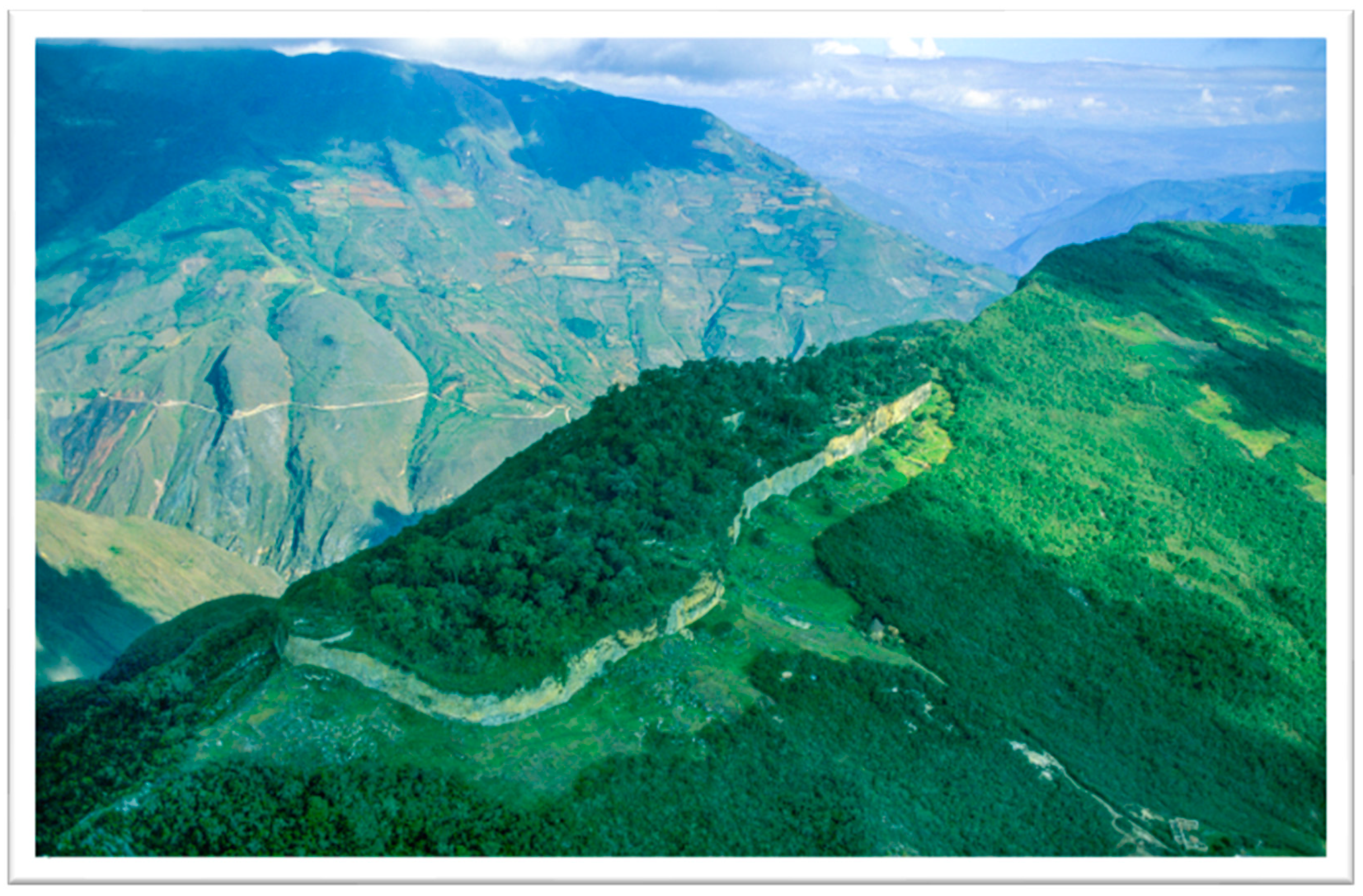
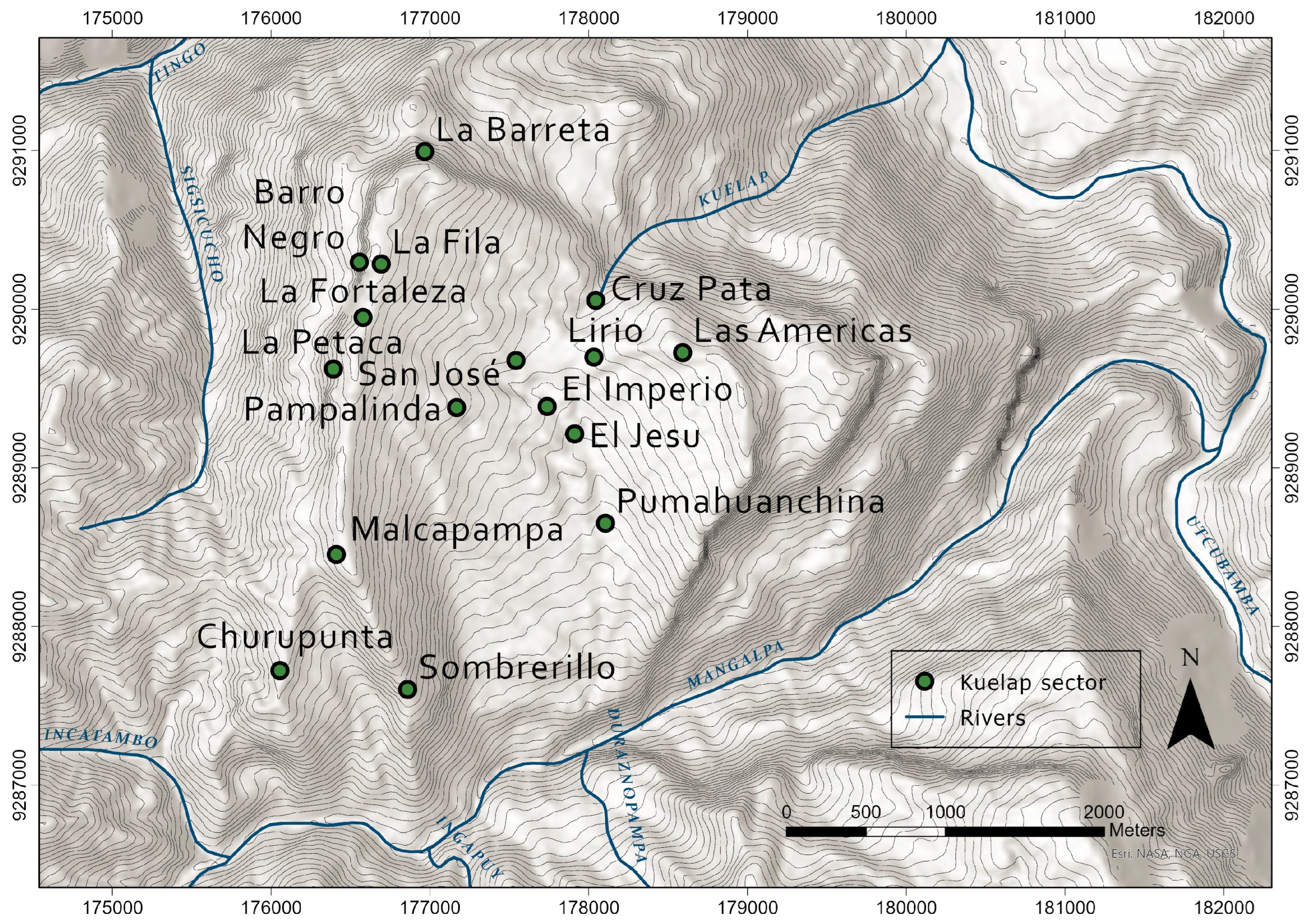
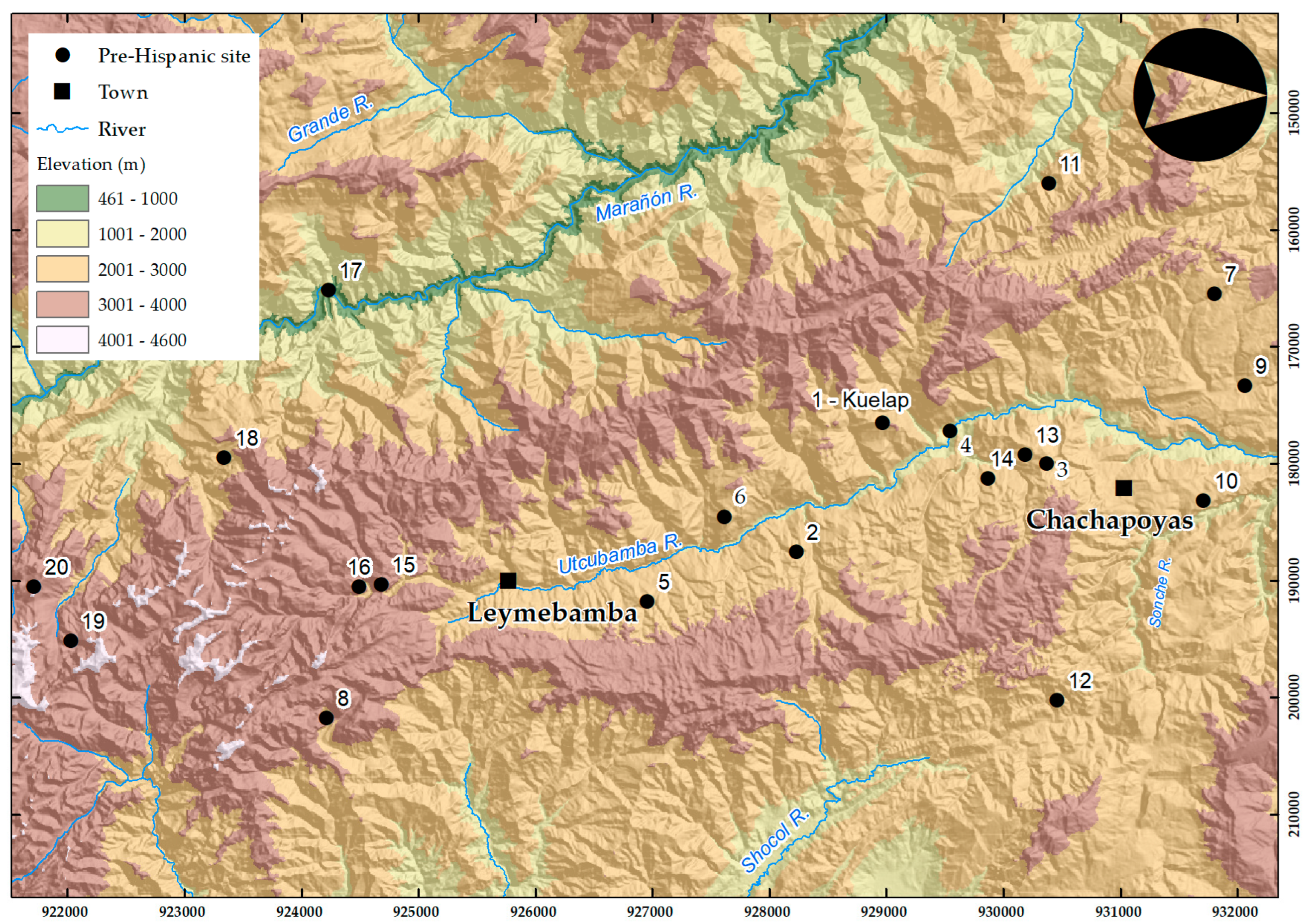


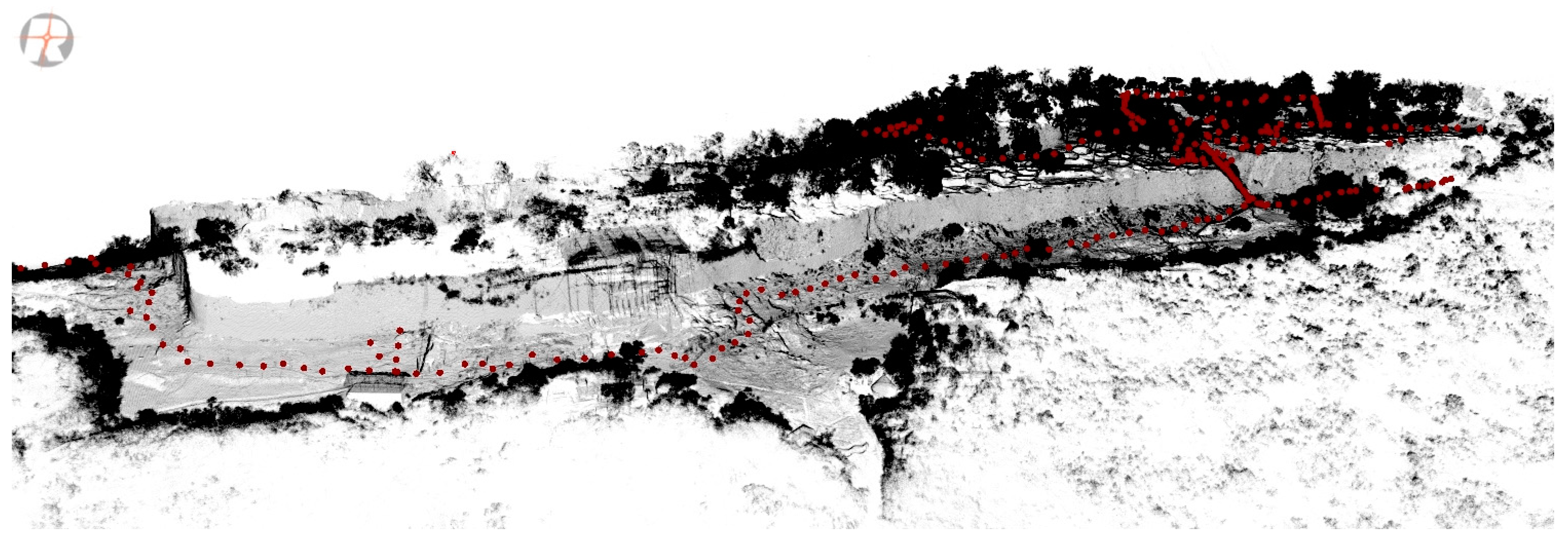

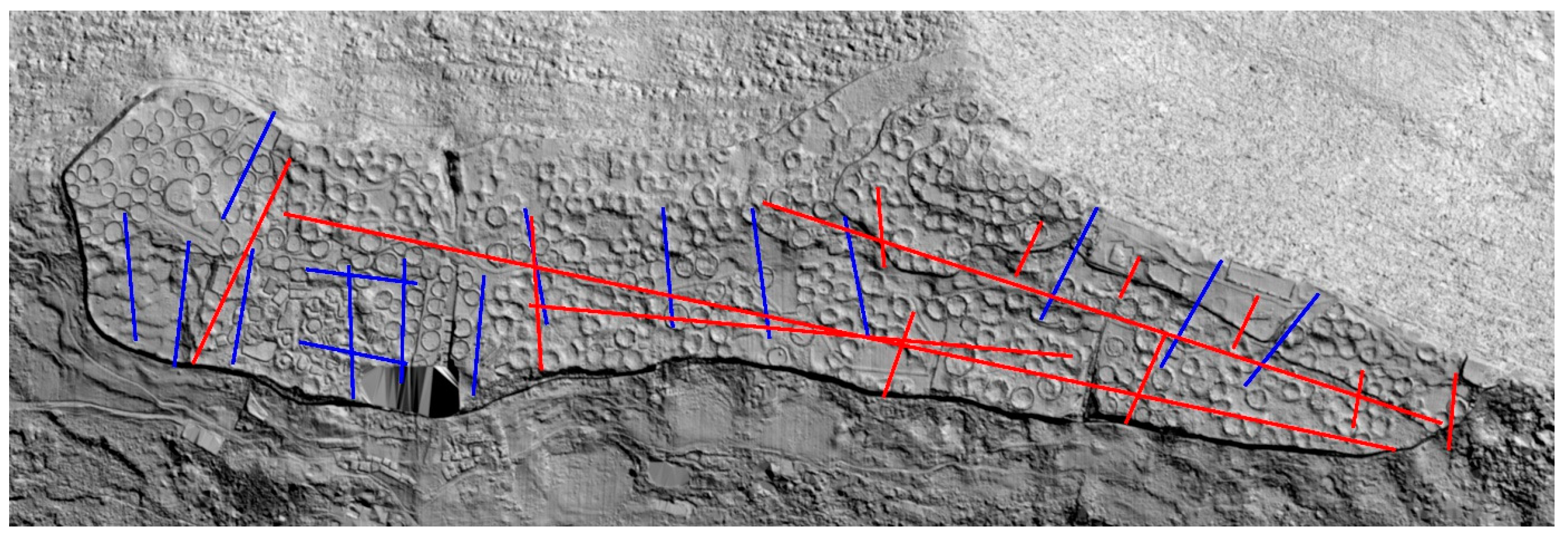


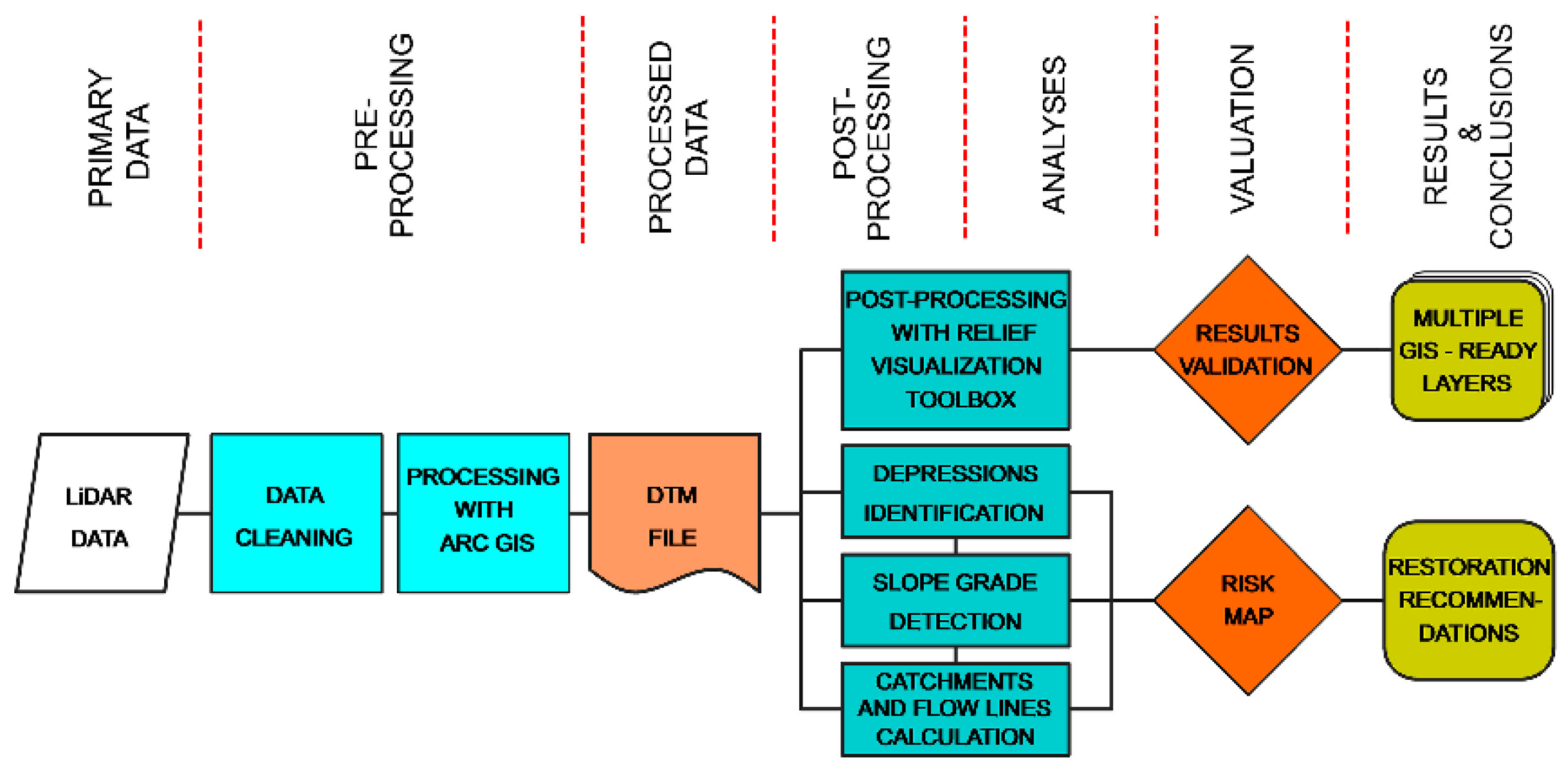
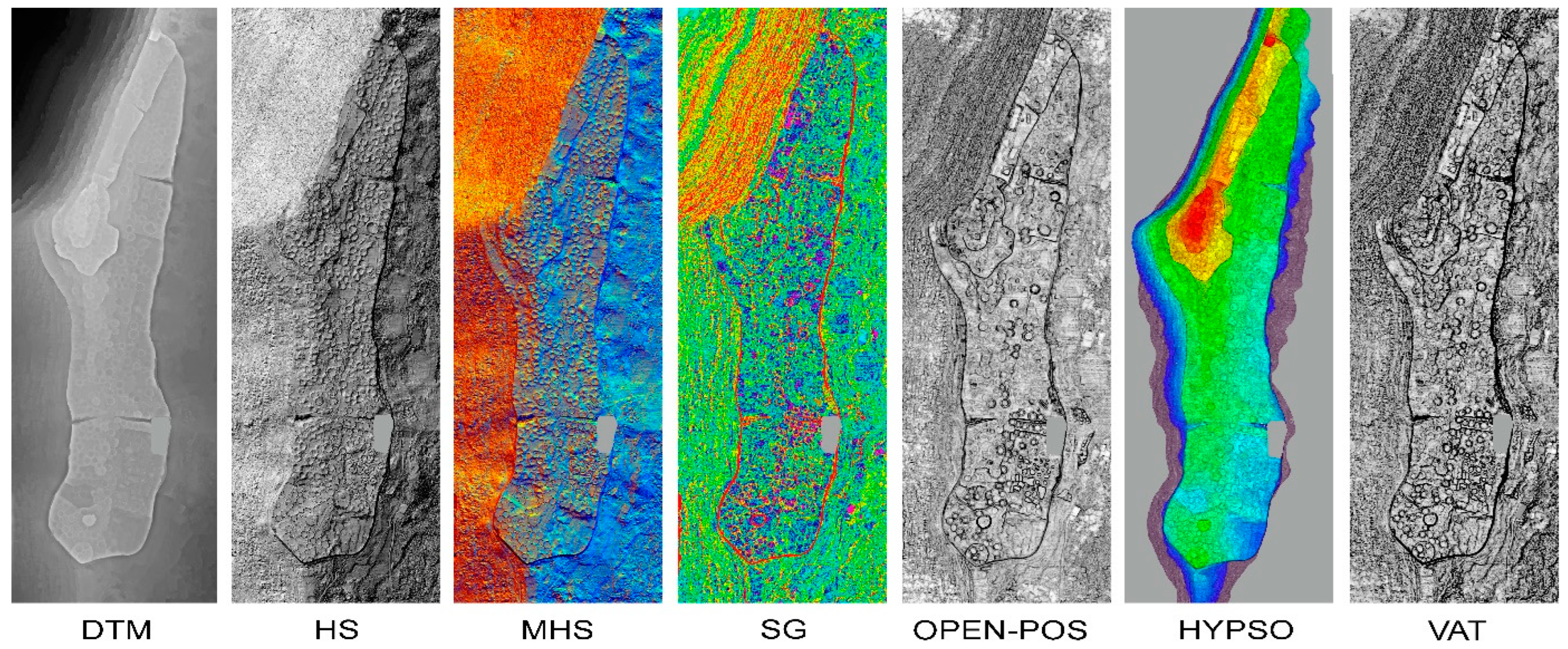
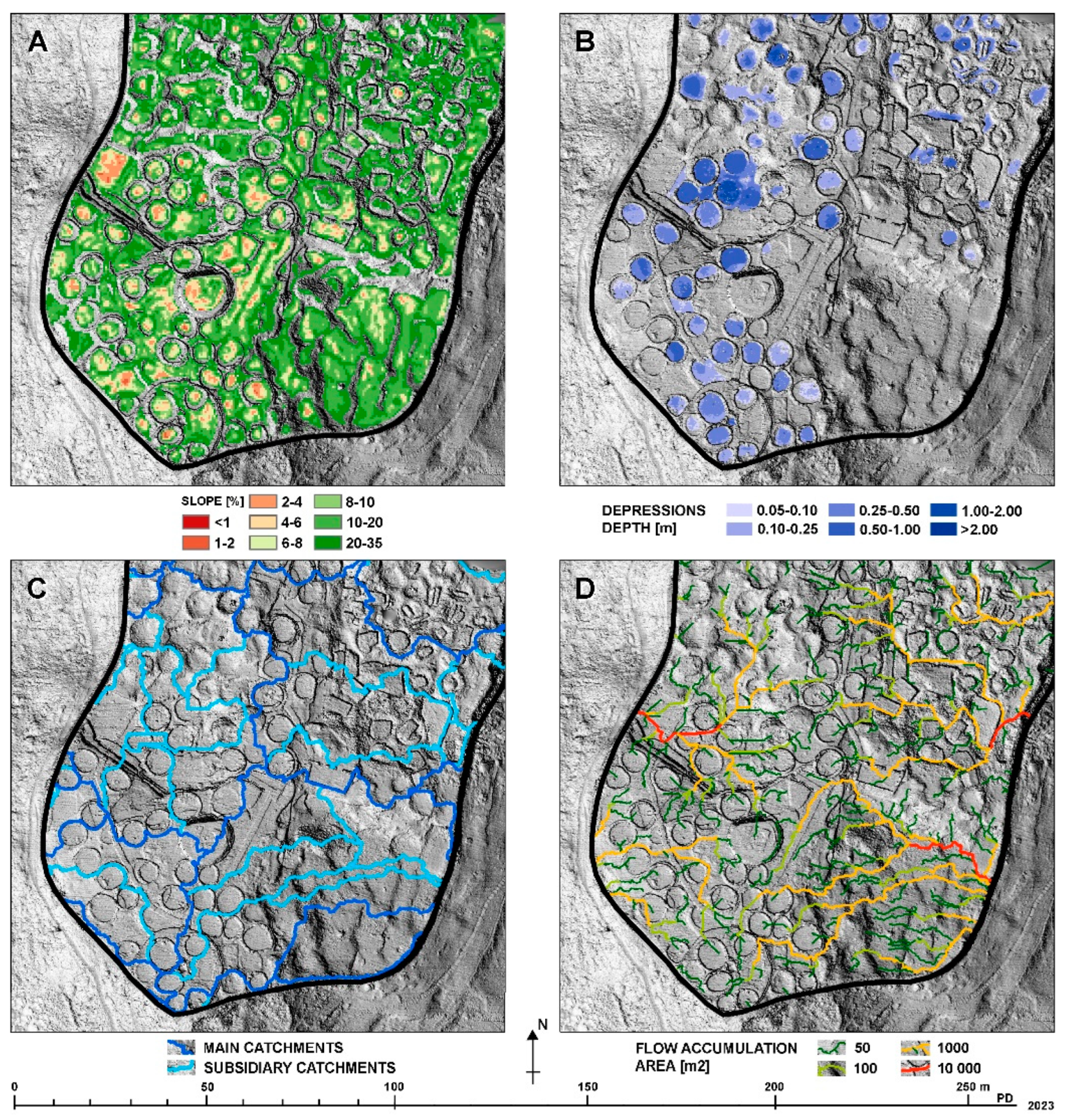
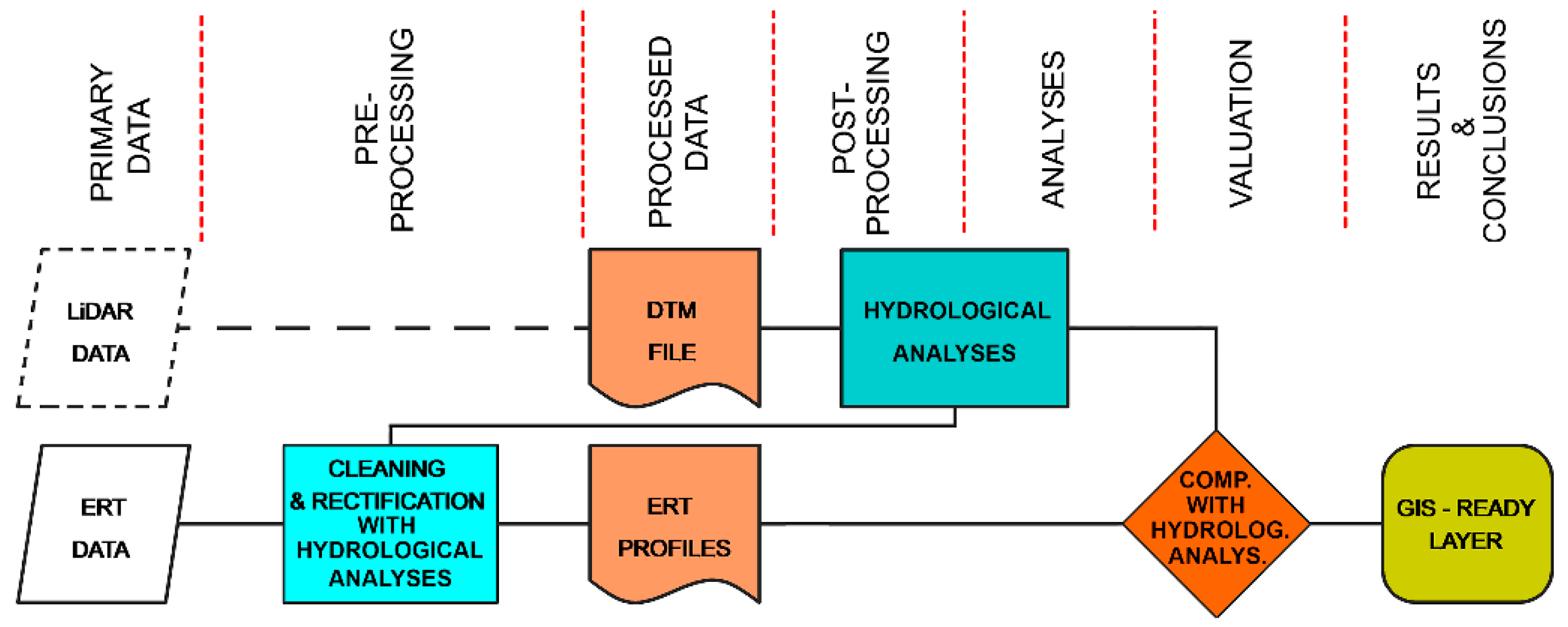
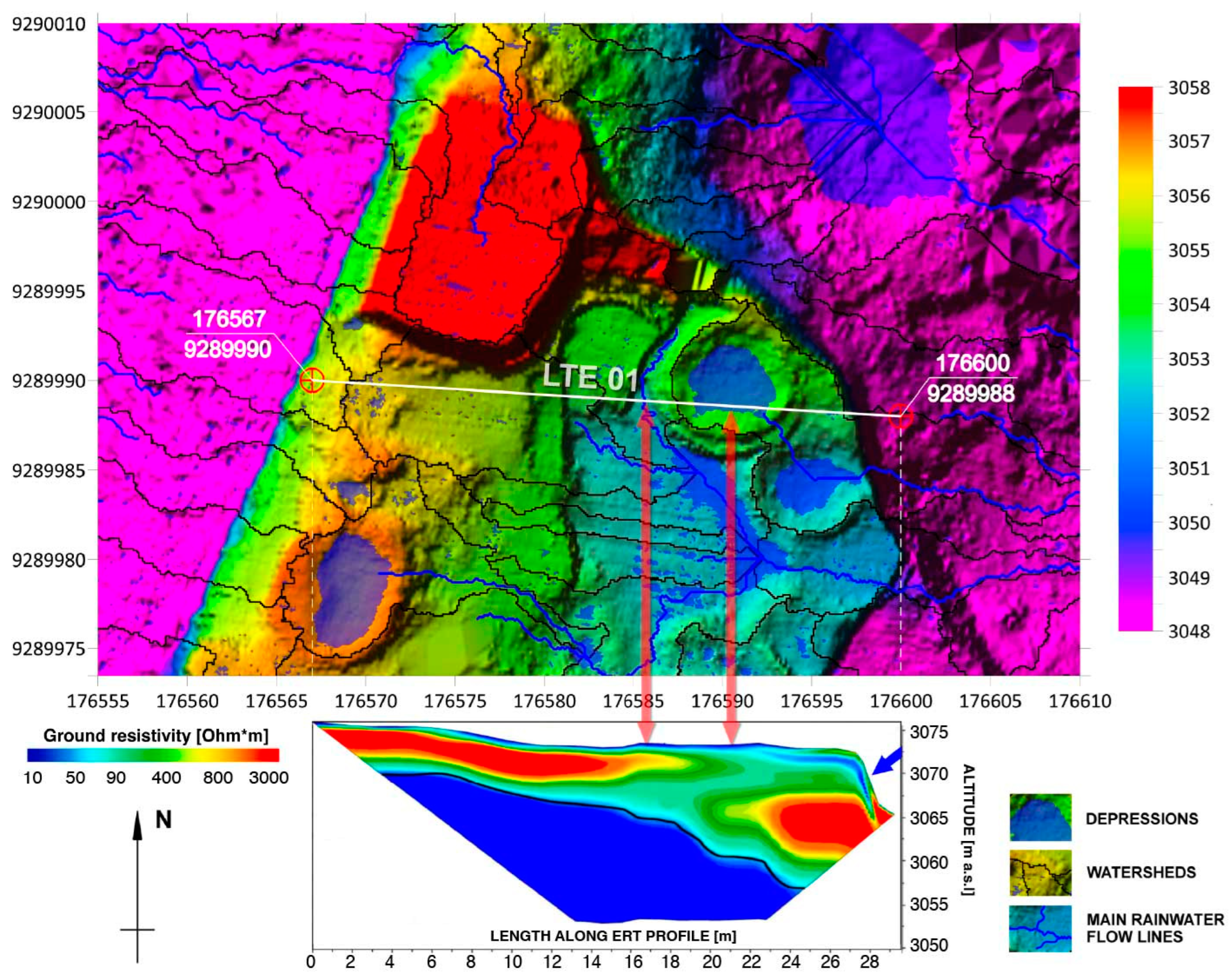
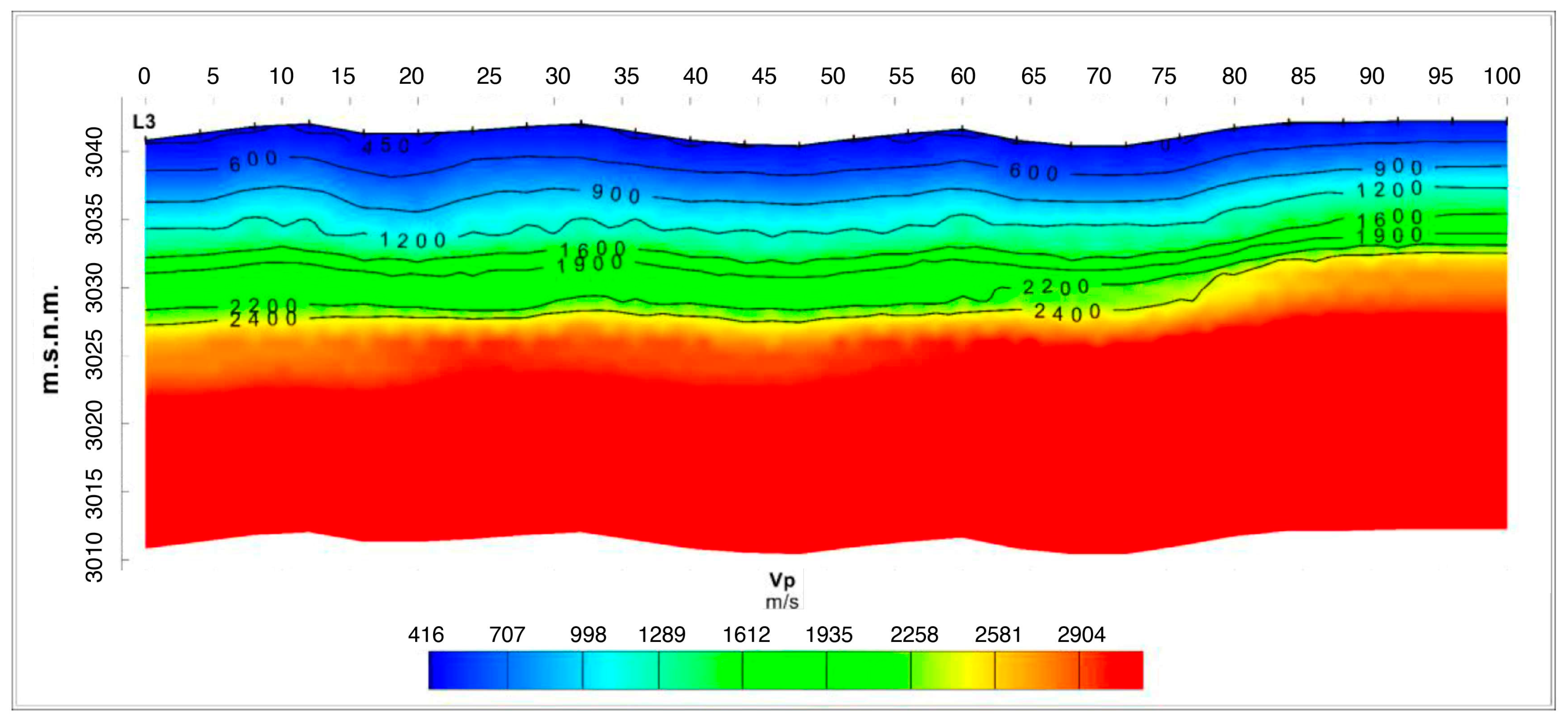
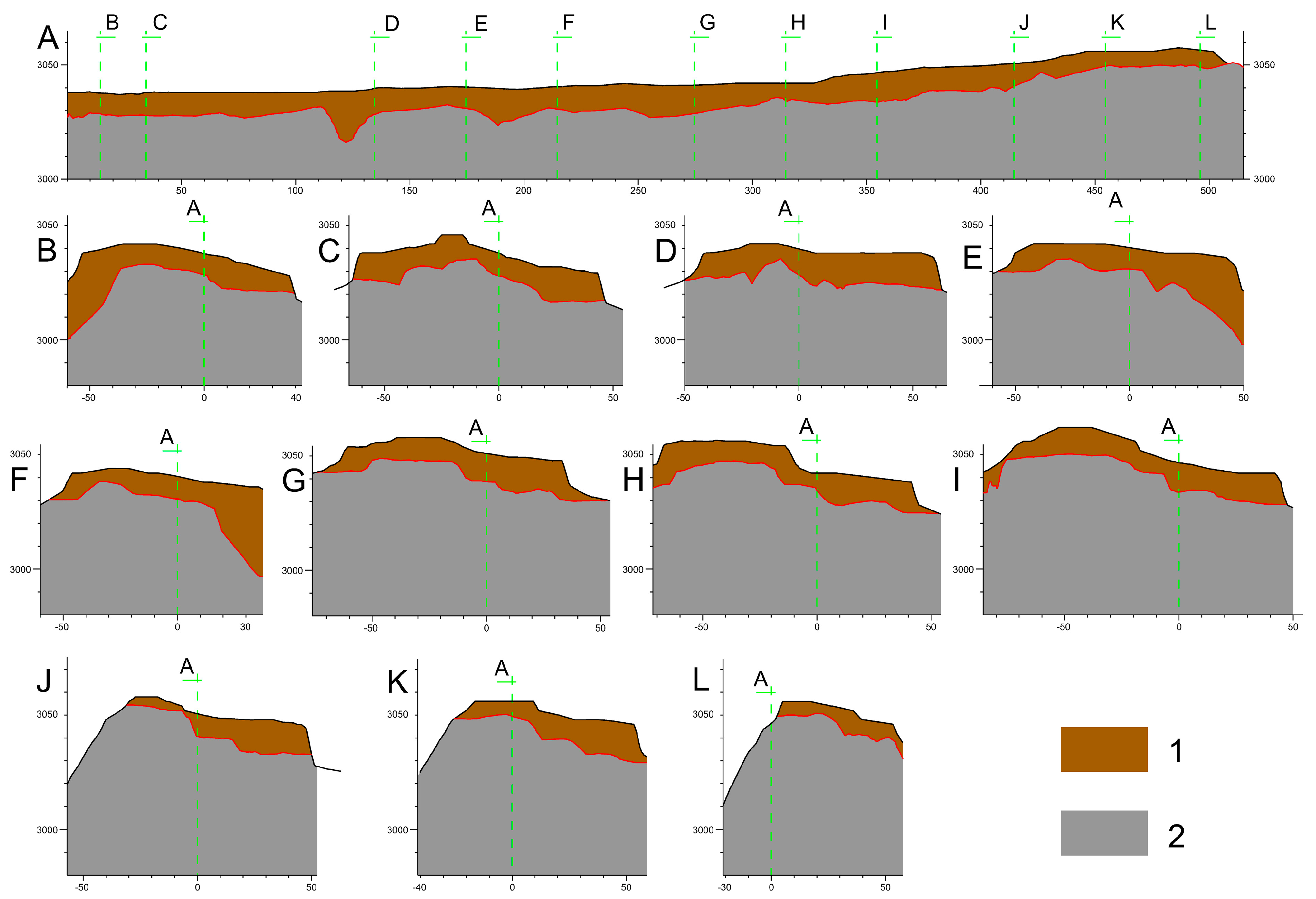
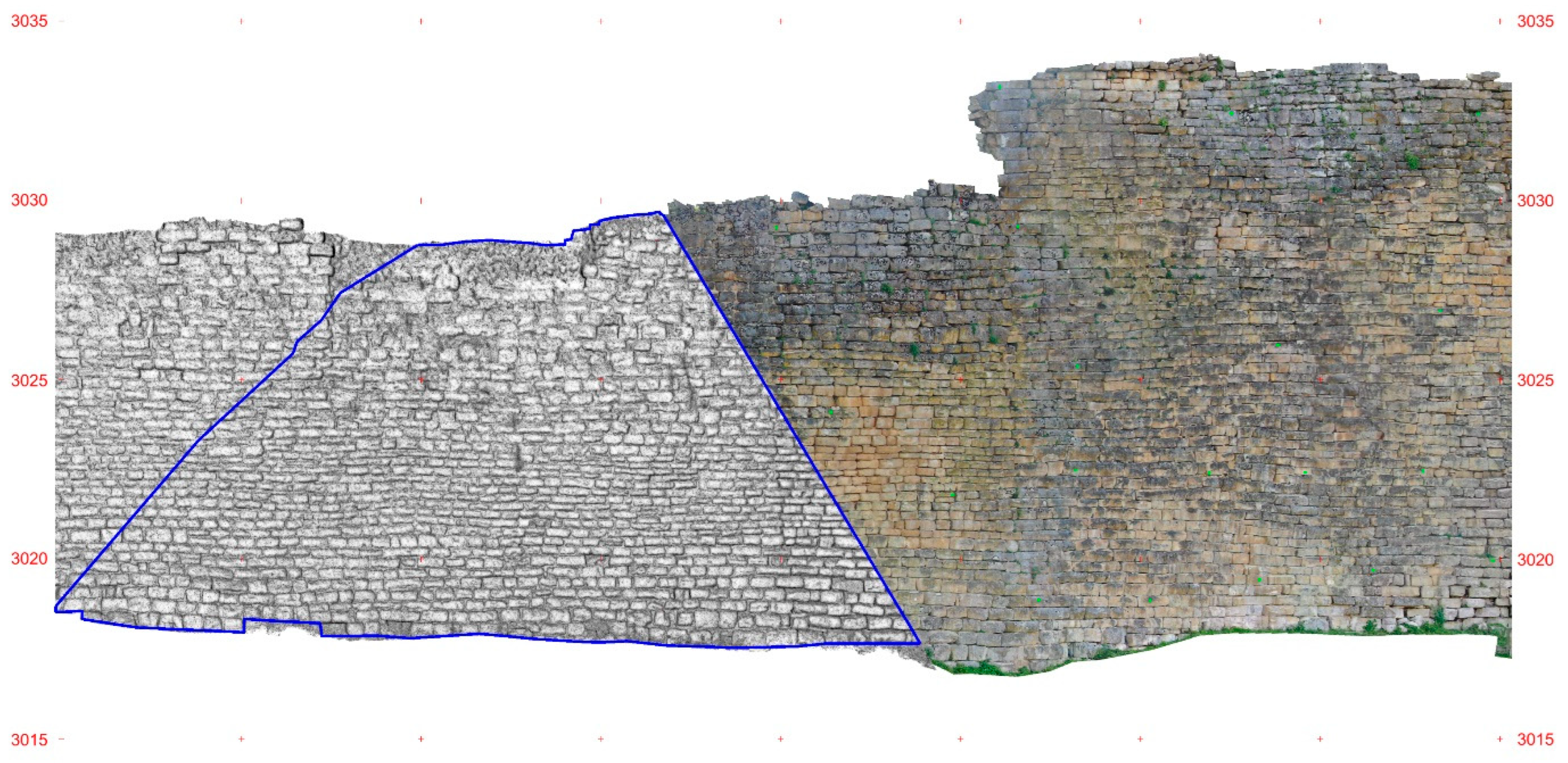

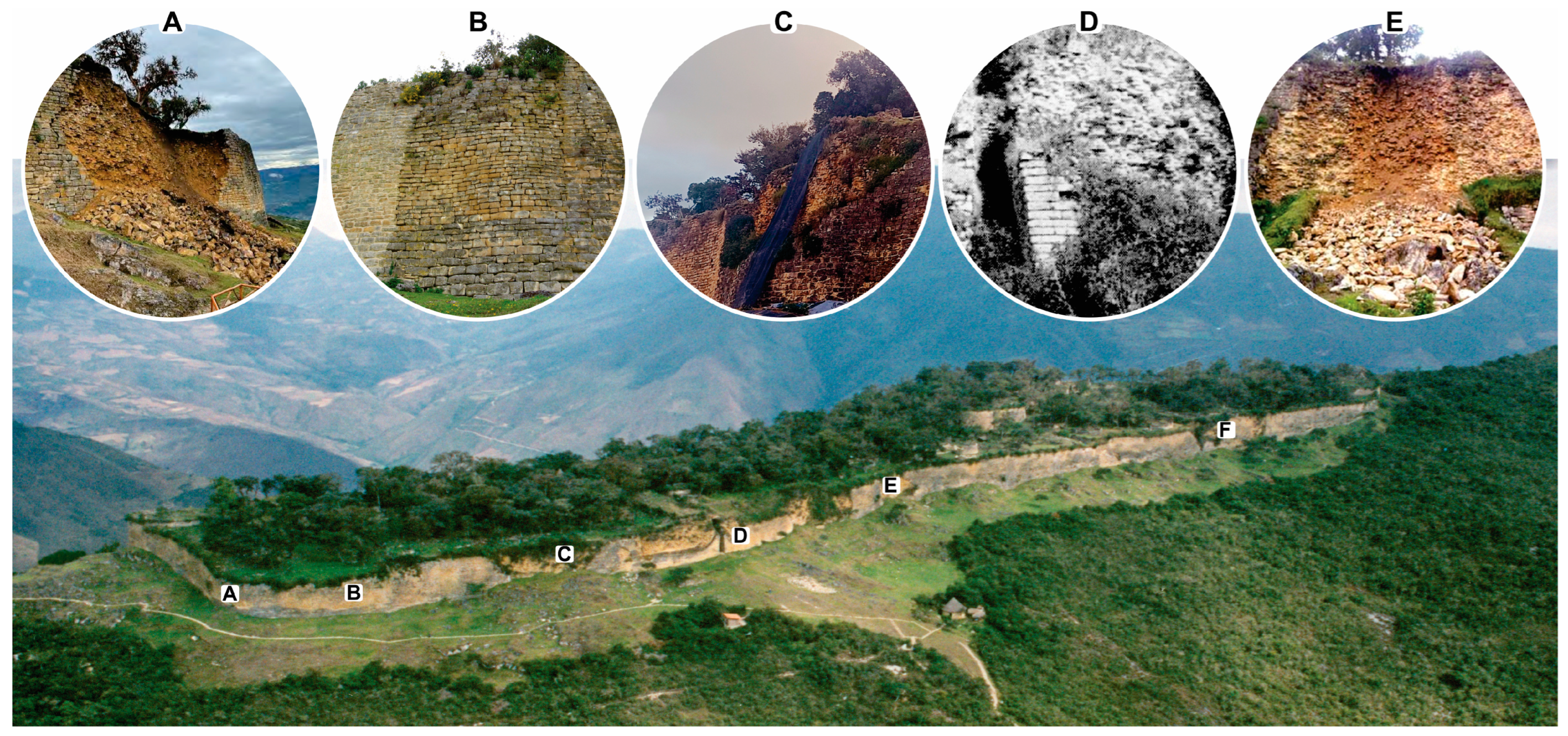
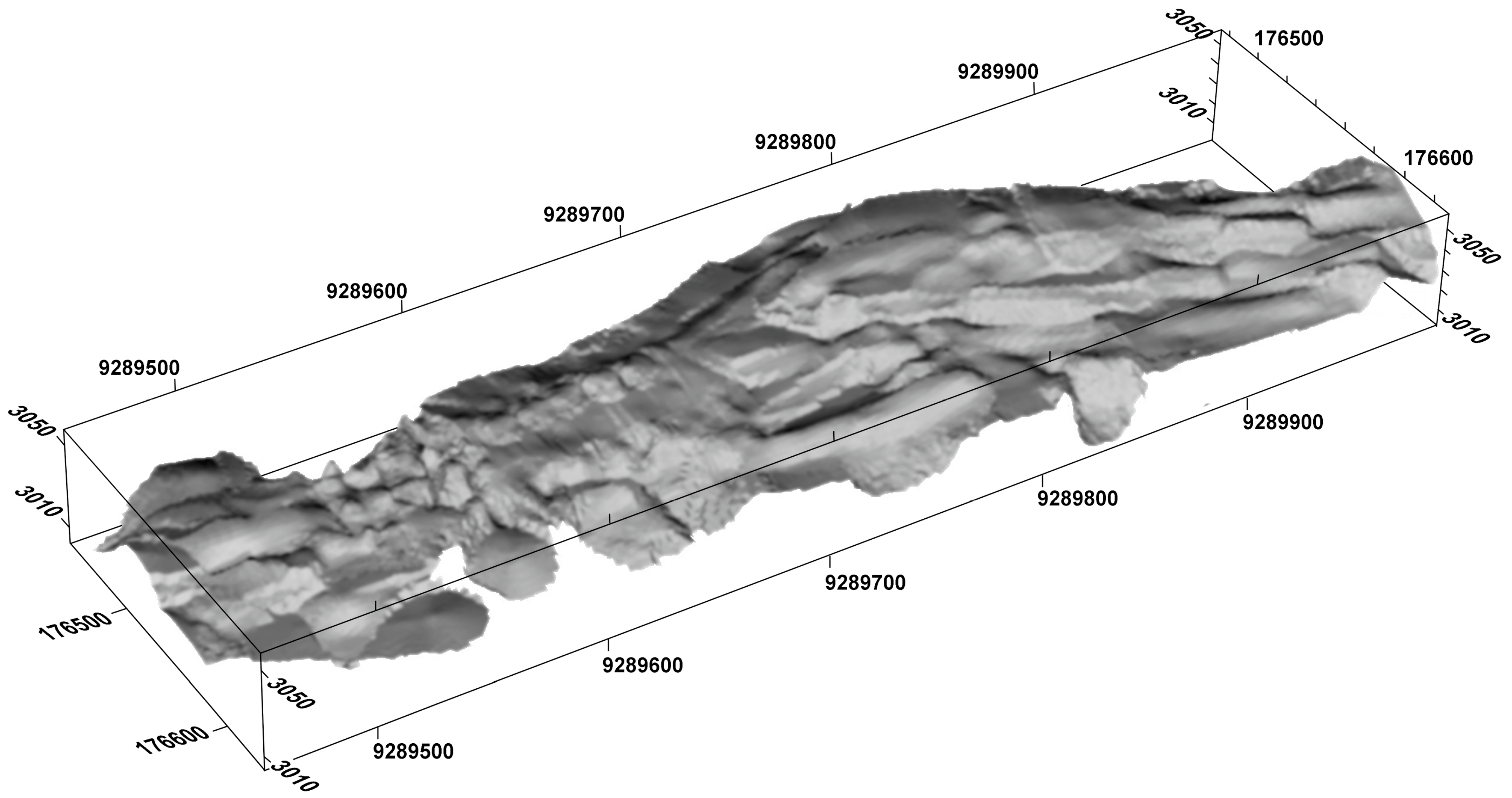
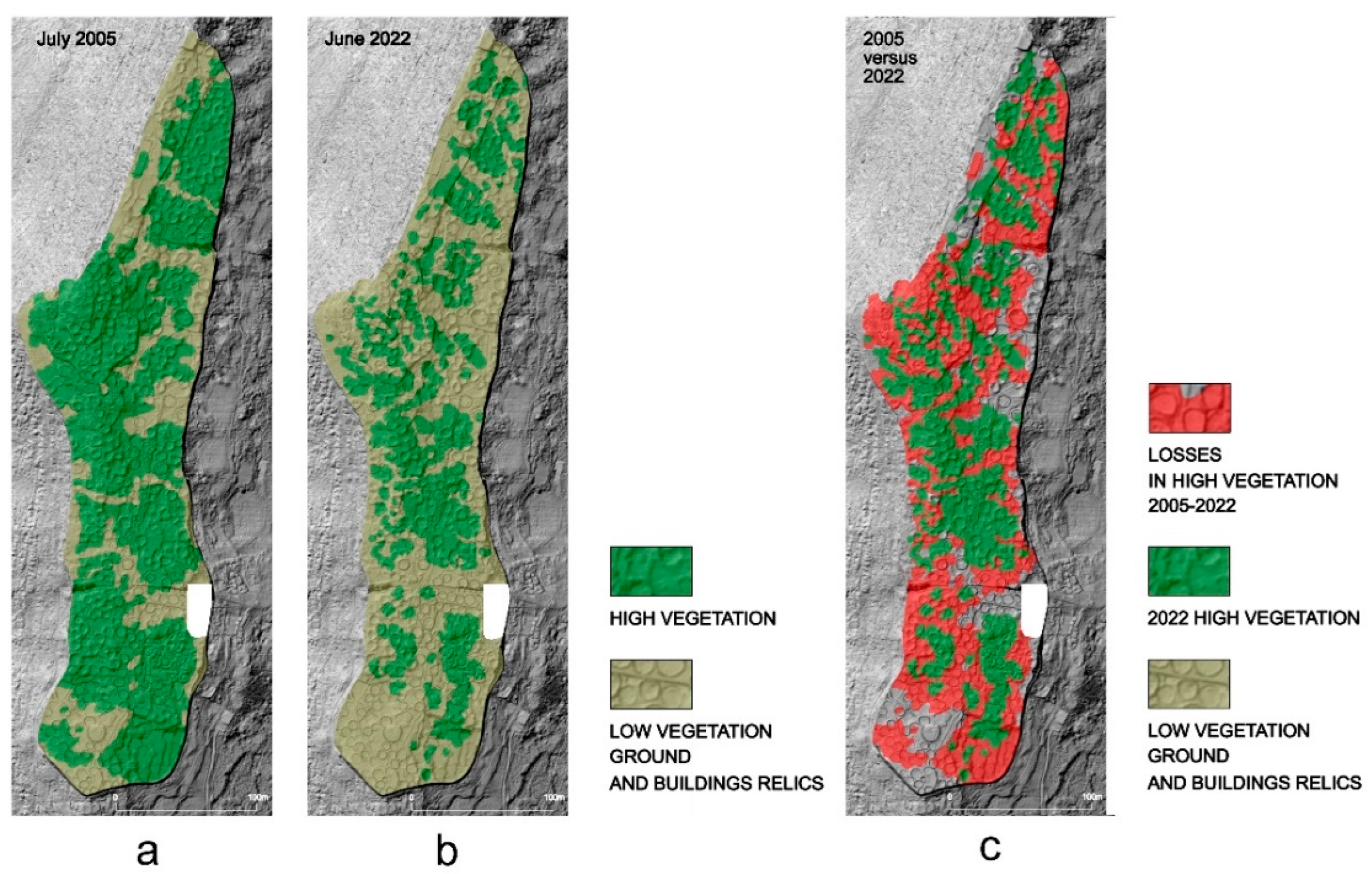
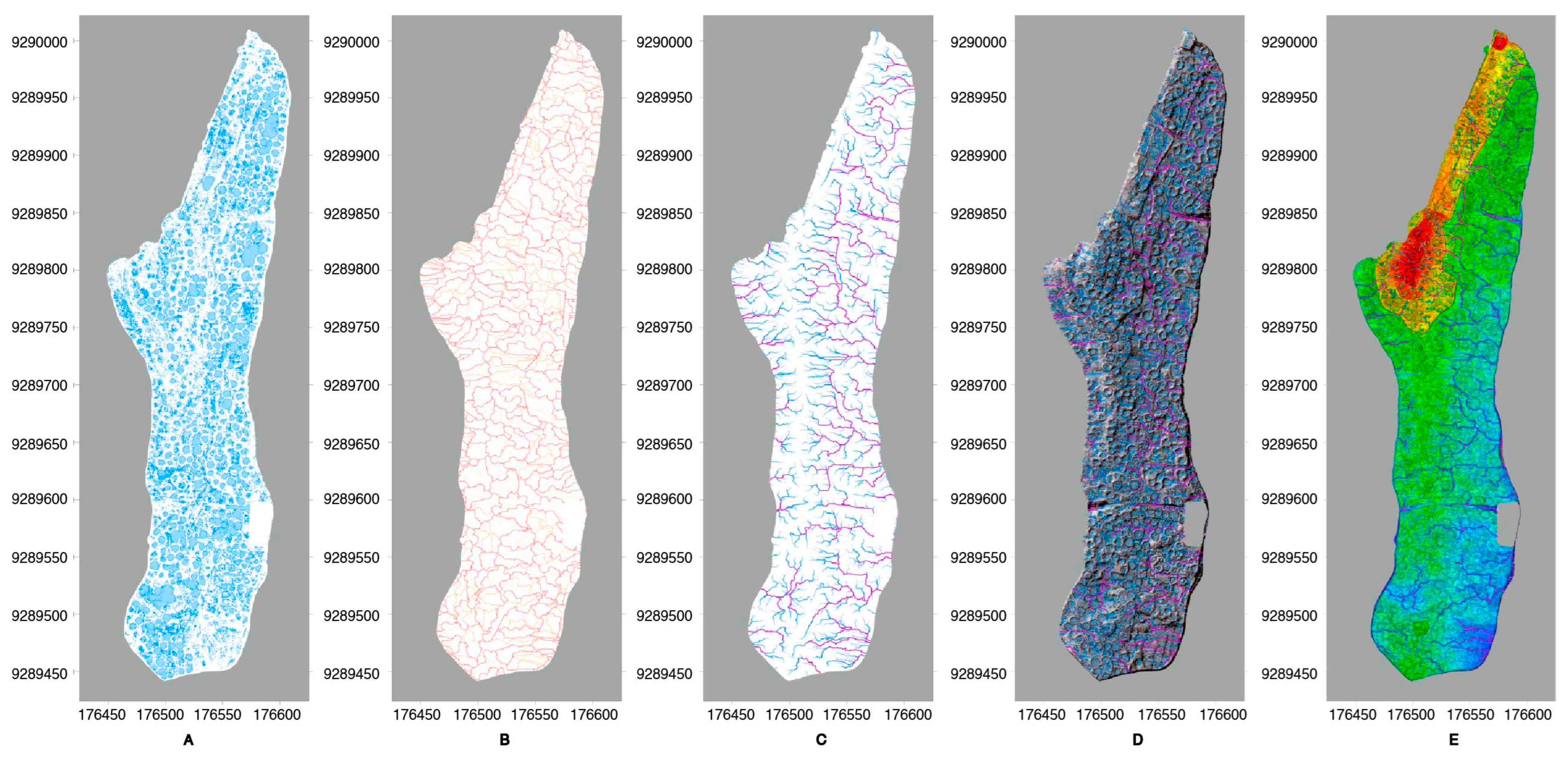

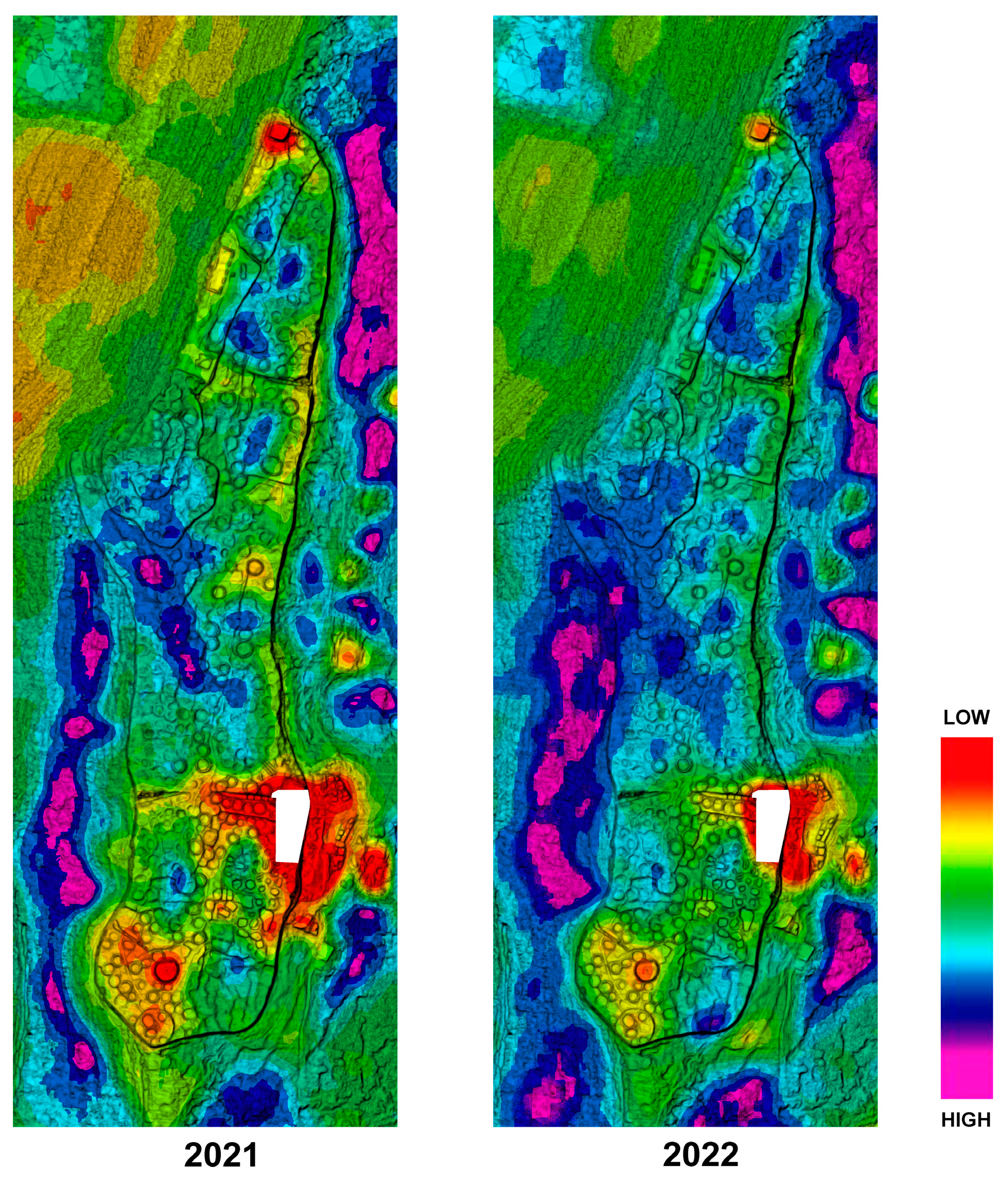
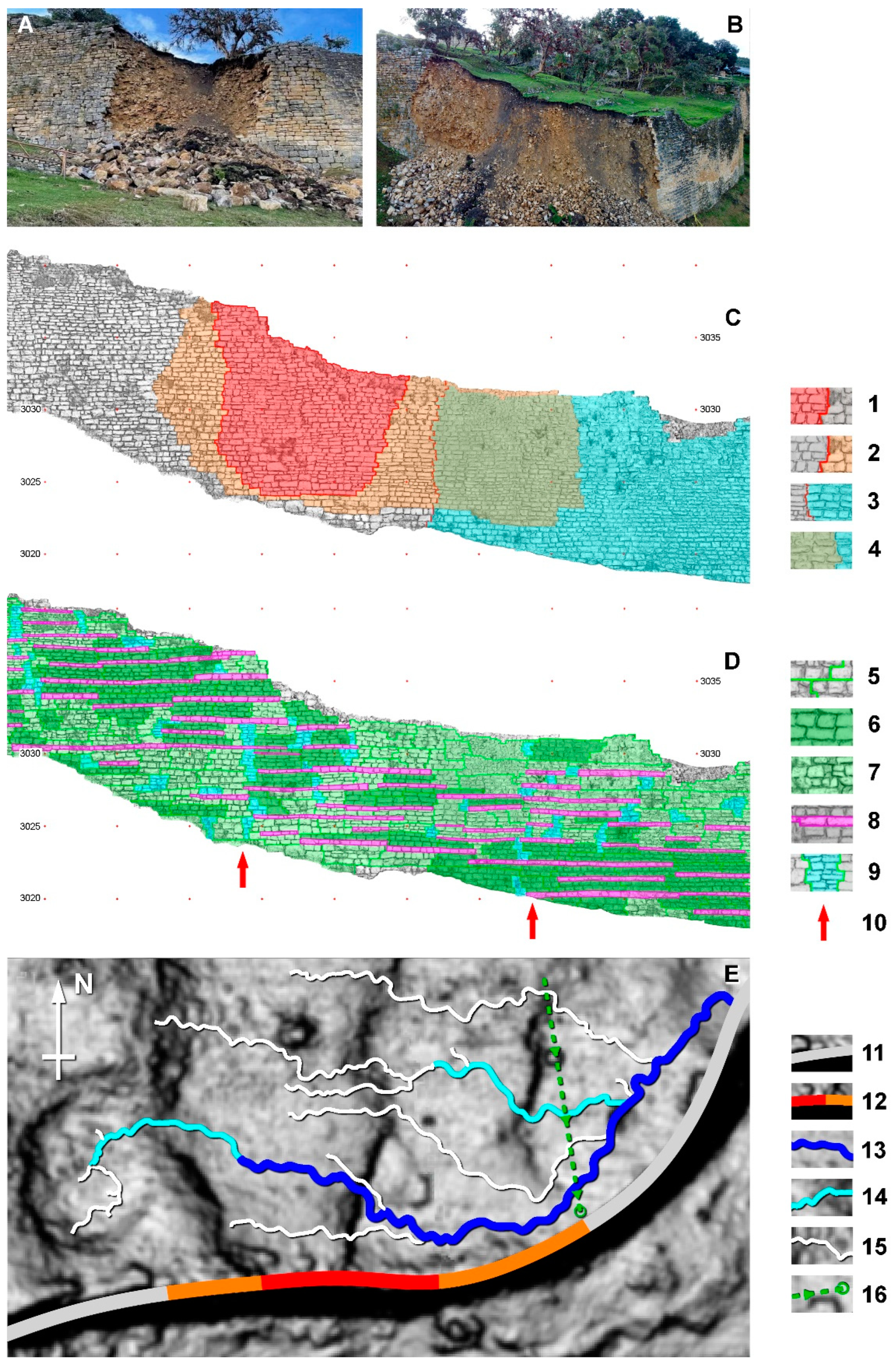
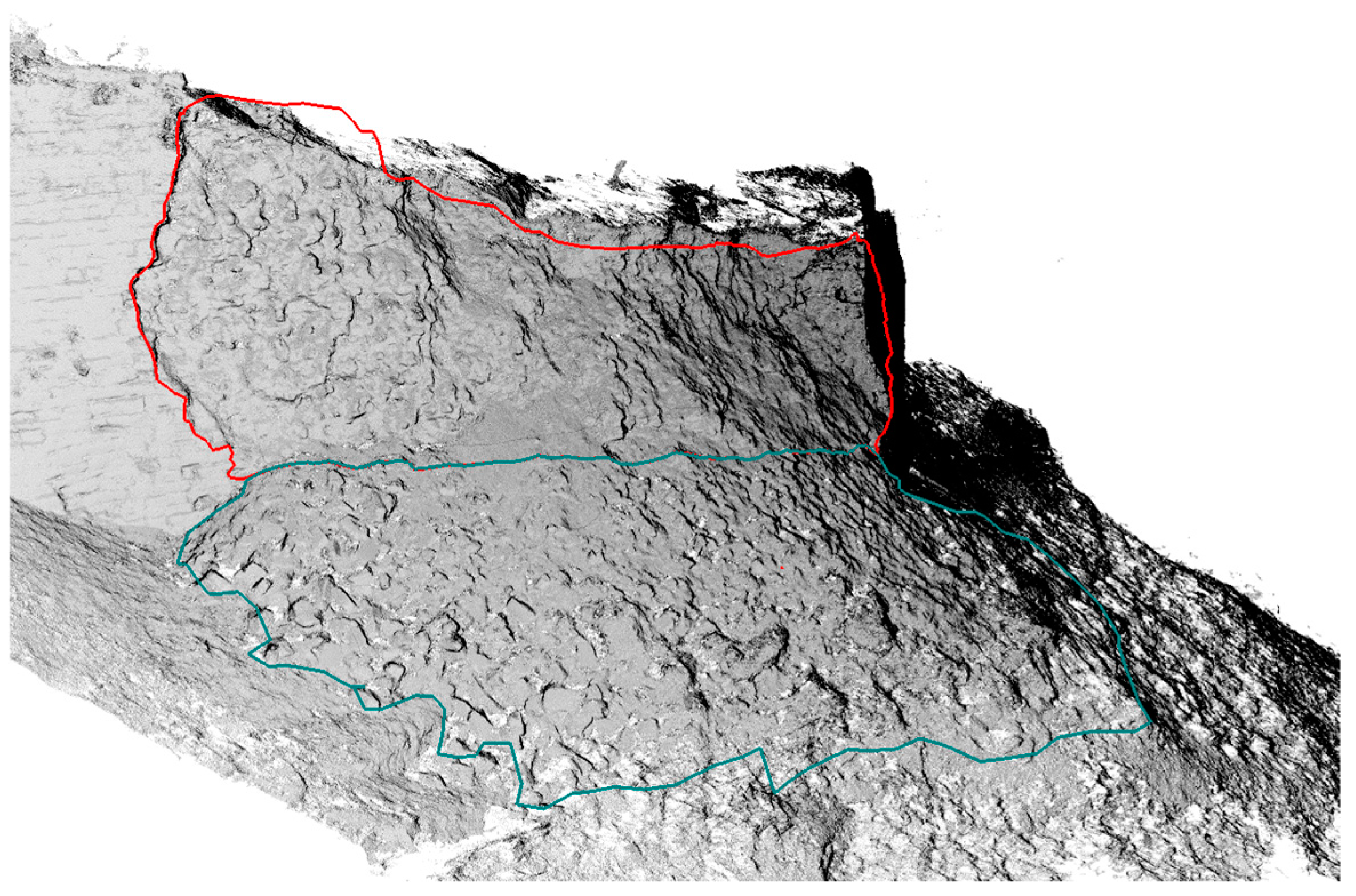
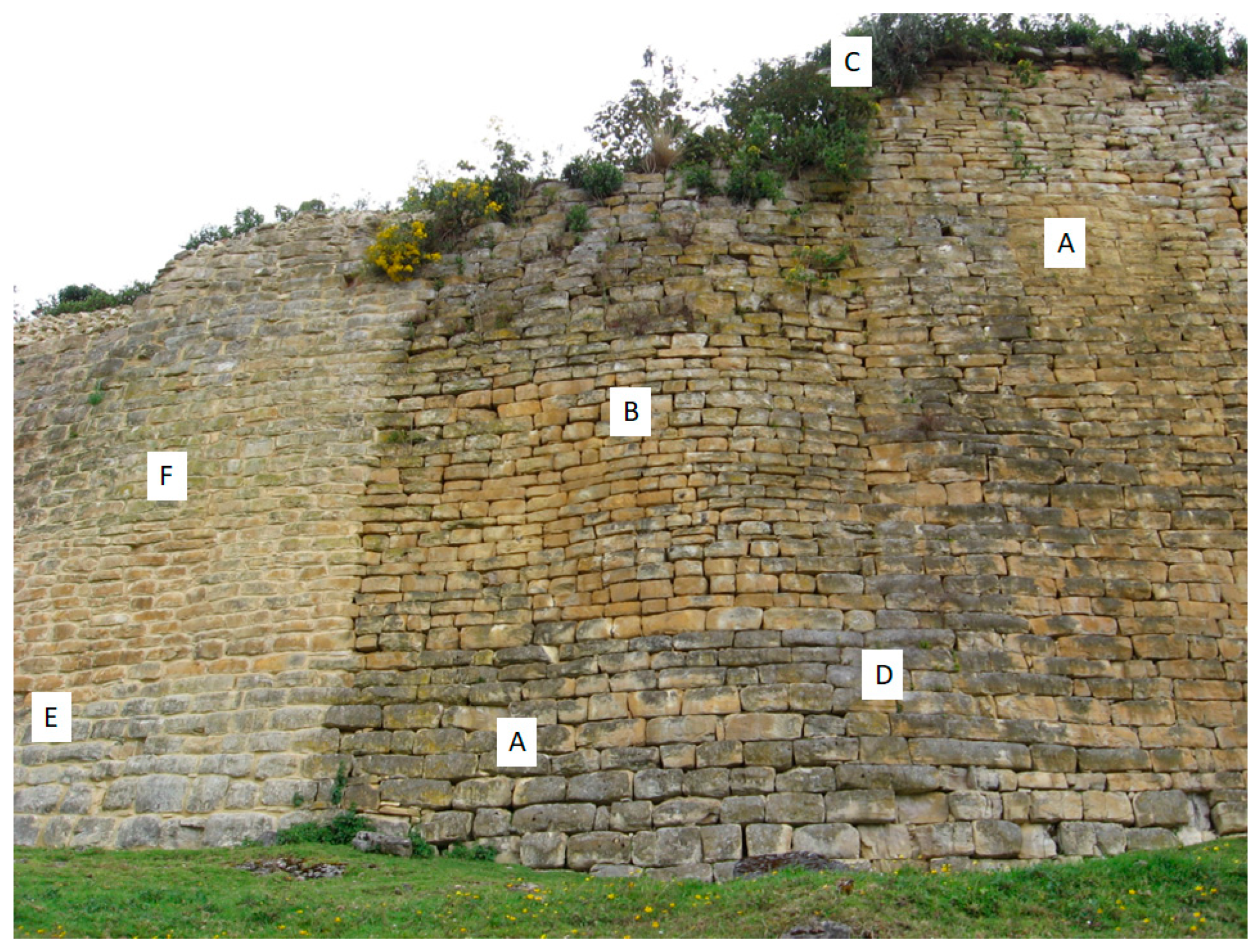
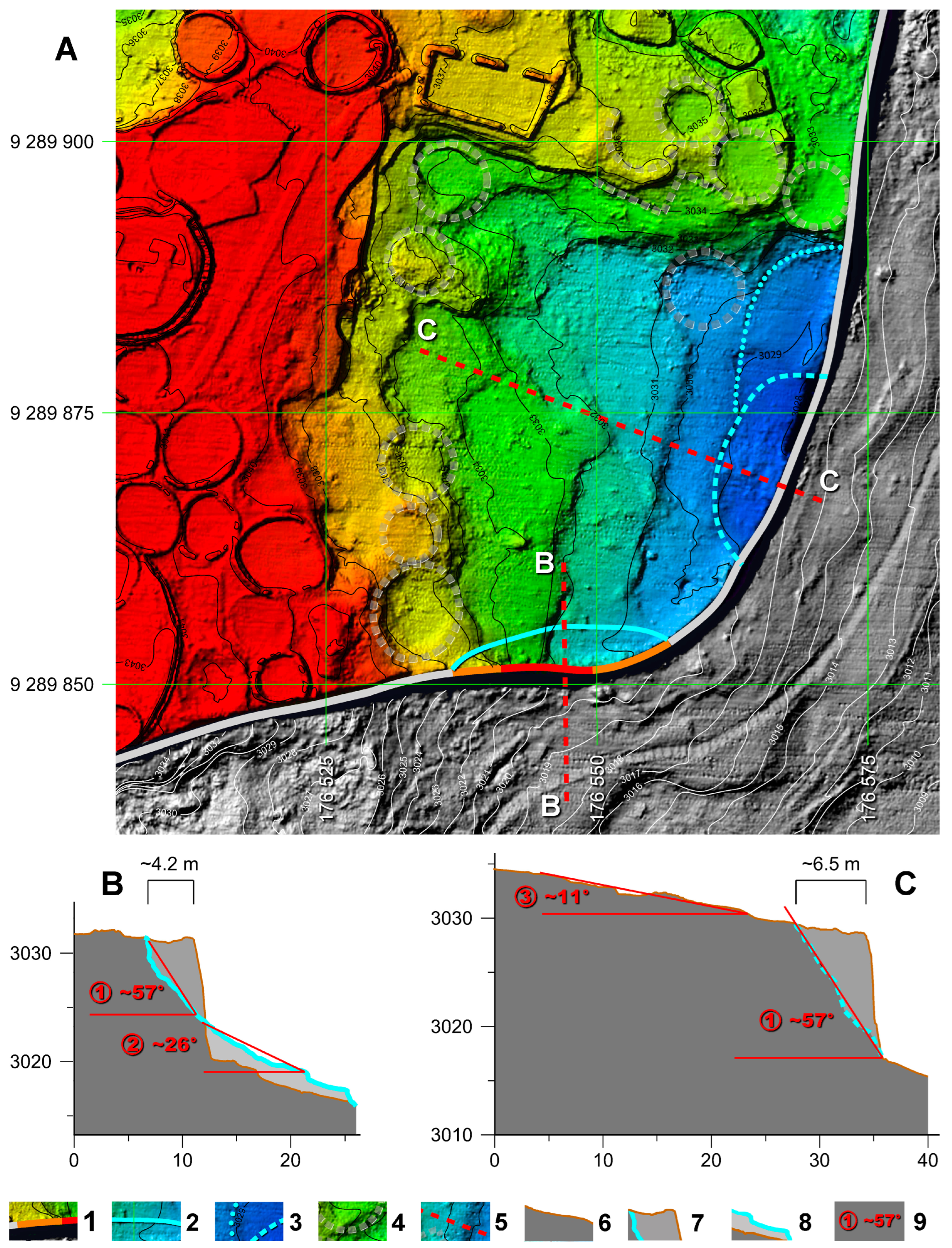

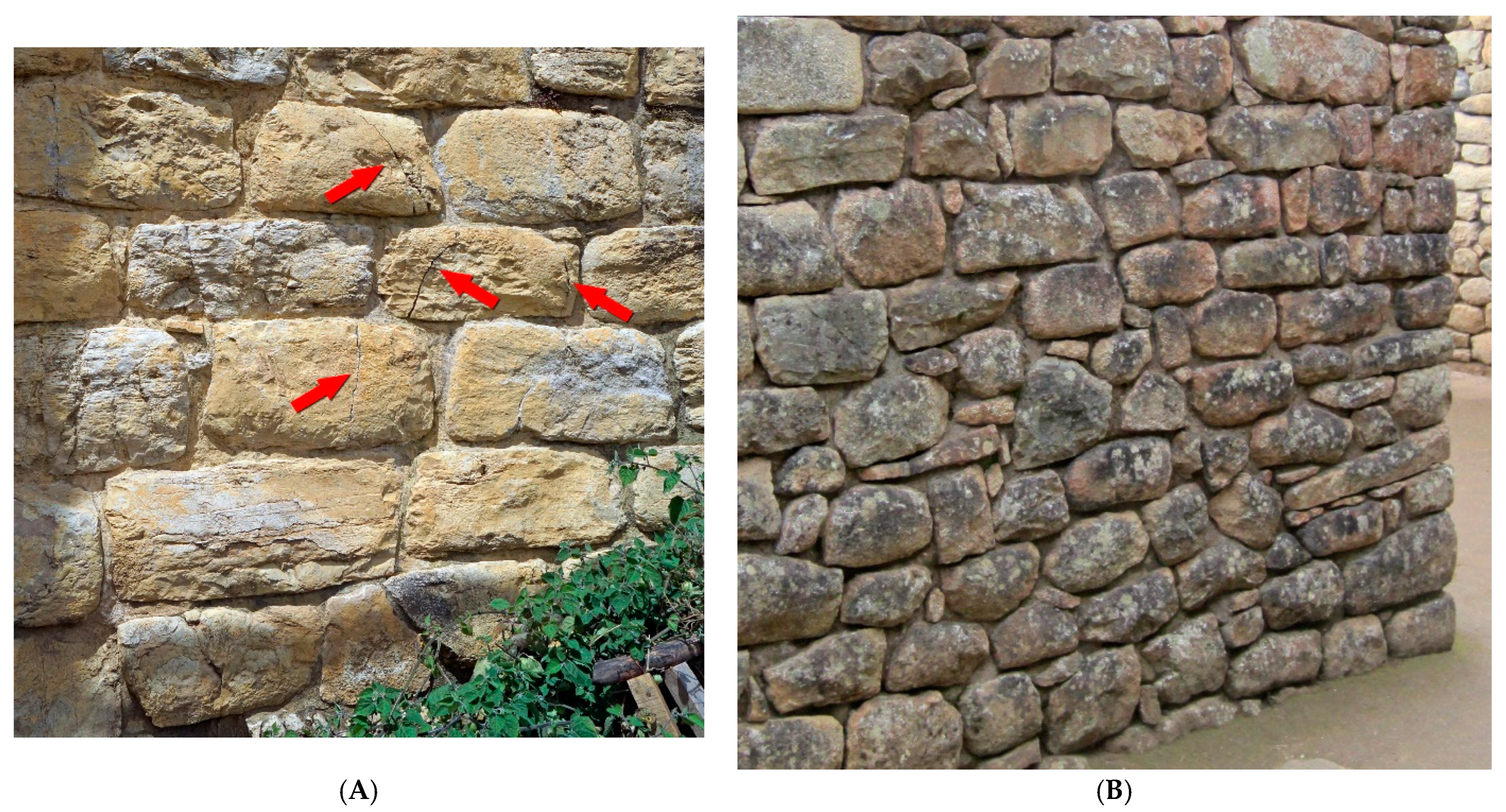
Disclaimer/Publisher’s Note: The statements, opinions and data contained in all publications are solely those of the individual author(s) and contributor(s) and not of MDPI and/or the editor(s). MDPI and/or the editor(s) disclaim responsibility for any injury to people or property resulting from any ideas, methods, instructions or products referred to in the content. |
© 2024 by the authors. Licensee MDPI, Basel, Switzerland. This article is an open access article distributed under the terms and conditions of the Creative Commons Attribution (CC BY) license (https://creativecommons.org/licenses/by/4.0/).
Share and Cite
Ghezzi, I.; Kościuk, J.; Church, W.; VanValkenburgh, P.; Ćmielewski, B.; Kucera, M.; Dąbek, P.B.; Contreras, J.; Mori, N.; Righetti, G.; et al. Assessing Conservation Conditions at La Fortaleza de Kuelap, Peru, Based on Integrated Close-Range Remote Sensing and Near-Surface Geophysics. Remote Sens. 2024, 16, 1053. https://doi.org/10.3390/rs16061053
Ghezzi I, Kościuk J, Church W, VanValkenburgh P, Ćmielewski B, Kucera M, Dąbek PB, Contreras J, Mori N, Righetti G, et al. Assessing Conservation Conditions at La Fortaleza de Kuelap, Peru, Based on Integrated Close-Range Remote Sensing and Near-Surface Geophysics. Remote Sensing. 2024; 16(6):1053. https://doi.org/10.3390/rs16061053
Chicago/Turabian StyleGhezzi, Ivan, Jacek Kościuk, Warren Church, Parker VanValkenburgh, Bartłomiej Ćmielewski, Matthias Kucera, Paweł B. Dąbek, Jeff Contreras, Nilsson Mori, Giovanni Righetti, and et al. 2024. "Assessing Conservation Conditions at La Fortaleza de Kuelap, Peru, Based on Integrated Close-Range Remote Sensing and Near-Surface Geophysics" Remote Sensing 16, no. 6: 1053. https://doi.org/10.3390/rs16061053
APA StyleGhezzi, I., Kościuk, J., Church, W., VanValkenburgh, P., Ćmielewski, B., Kucera, M., Dąbek, P. B., Contreras, J., Mori, N., Righetti, G., Serafini, S., & Rojas, C. (2024). Assessing Conservation Conditions at La Fortaleza de Kuelap, Peru, Based on Integrated Close-Range Remote Sensing and Near-Surface Geophysics. Remote Sensing, 16(6), 1053. https://doi.org/10.3390/rs16061053






